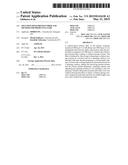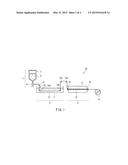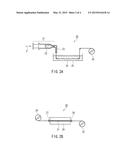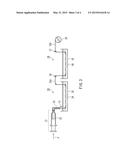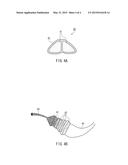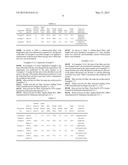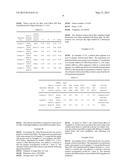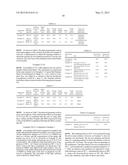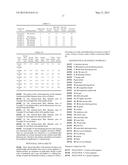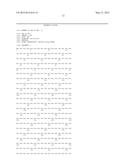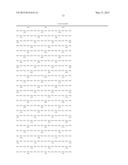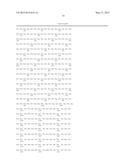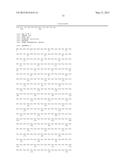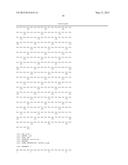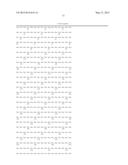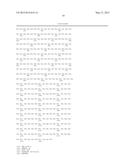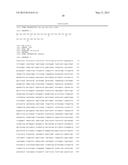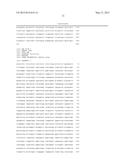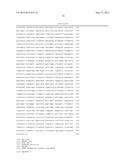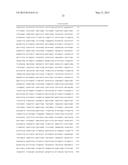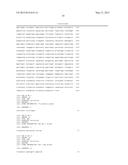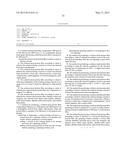Patent application title: SOLUTION-DYED PROTEIN FIBER AND METHOD FOR PRODUCING SAME
Inventors:
Mizuki Ishikawa (Tsuruoka-Shi, JP)
Kazuhide Sekiyama (Tsuruoka-Shi, JP)
IPC8 Class: AD01F402FI
USPC Class:
530353
Class name: Chemistry: natural resins or derivatives; peptides or proteins; lignins or reaction products thereof proteins, i.e., more than 100 amino acid residues scleroproteins, e.g., fibroin, elastin, silk, etc.
Publication date: 2015-05-21
Patent application number: 20150141618
Abstract:
A solution-dyed protein fiber of the present invention includes 0-100
mass % of silk fibroin and 100-0 mass % of a polypeptide derived from
spider silk proteins when the protein fiber is assumed to be 100 mass %,
wherein the solution-dyed protein fiber contains a solution-dyeing
colorant. The fiber is obtained by: dissolving or dispersing a
solution-dyeing colorant in a solvent used for a spinning solution or in
dimethyl sulfoxide, thereby preparing a coloring liquid; adding a solvent
to the coloring liquid in an amount necessary for a spinning solution;
adding and dissolving protein powder into the solvent, thereby preparing
a spinning solution; and subjecting the spinning solution to wet spinning
or dry-wet spinning. Thereby, the present invention provides a low-cost
solution-dyed protein fiber in which a solution-dyeing colorant is
dispersed uniformly and that can exhibit bright color tone, and a method
for producing the same.Claims:
1. A solution-dyed protein fiber comprising 0-100 mass % of silk fibroin
and 100-0 mass % of a polypeptide derived from spider silk proteins when
the protein fiber is assumed to be 100 mass %, wherein the solution-dyed
protein fiber contains a solution-dyeing colorant.
2. The solution-dyed protein fiber according to claim 1, wherein the solution-dyeing colorant is at least one selected from dyes and pigments.
3. The solution-dyed protein fiber according to claim 1, wherein the solution-dyeing colorant is at least one selected from an acid dye, a basic dye, a fluorescent dye, a direct dye, a disperse dye, a plant pigment, a food natural pigment, and a carbon black.
4. The solution-dyed protein fiber according to claim 1, wherein an abundance of the solution-dyeing colorant is in a range of 0.1 to 2 mass % based on 100 mass % of the protein fiber.
5. The solution-dyed protein fiber according to claim 1, wherein the solution-dyed protein fiber has a diameter in a range of 5 to 200 μm.
6. The solution-dyed protein fiber according to claim 1, wherein the solution-dyed protein fiber contains at least one inorganic salt selected from alkali metal halides, alkaline-earth metal halides, alkaline-earth metal nitrate, and sodium thiocyanate.
7. A method for producing a solution-dyed protein fiber comprising 0-100 mass % of silk fibroin and 100-0 mass % of a polypeptide derived from spider silk proteins when the protein fiber is assumed to be 100 mass %, the method comprising: dissolving or dispersing a solution-dyeing colorant in a solvent used for a spinning solution or in dimethyl sulfoxide, thereby preparing a coloring liquid; adding a solvent to the coloring liquid in an amount necessary for a spinning solution; adding and dissolving protein powder into the solvent, thereby preparing a spinning solution; and subjecting the spinning solution to wet spinning or dry-wet spinning.
8. The method for producing a solution-dyed protein fiber according to claim 7, wherein an undrawn yarn of the solution-dyed protein fiber after the wet spinning is heat drawn under dry heat.
9. The method for producing a solution-dyed protein fiber according to claim 8, wherein conditions for the dry-heat drawing are at a temperature of 160.degree. C. or higher and a draw ratio of 1.05 to 4 times.
10. The method for producing a solution-dyed protein fiber according to claim 8, wherein, before the dry-heat drawing, the undrawn yarn is drawn in water bath in advance.
11. The method for producing a solution-dyed protein fiber according to claim 10, wherein conditions for the water-bath drawing are at a temperature of 30.degree. C. to 90.degree. C. and a draw ratio of 1.05 to 6 times.
12. The method for producing a solution-dyed protein fiber according to claim 7, wherein the solution-dyeing colorant is at least one selected from dyes and pigments.
13. The method for producing a solution-dyed protein fiber according to claim 7, wherein the solution-dyeing colorant is at least one selected from an acid dye, a basic dye, a fluorescent dye, a direct dye, a disperse dye, a plant pigment, a food natural pigment, and a carbon black.
14. The method for producing a solution-dyed protein fiber according to claim 7, wherein 0.1 to 2 mass % of the solution-dyeing colorant is added based on 100 mass % of the protein fiber.
15. The method for producing a solution-dyed protein fiber according to claim 7, wherein, as a solvent for dissolving a protein fiber, the spinning solution includes a solvent that contains dimethyl sulfoxide and at least one inorganic salt selected from alkali metal halides, alkaline-earth metal halides, alkaline-earth metal nitrate, and sodium thiocyanate.
Description:
TECHNICAL FIELD
[0001] The present invention relates to a solution-dyed protein fiber to which a solution-dyeing colorant has been added before a spinning process, and a method for producing the same.
BACKGROUND ART
[0002] As protein fibers, fibroin fibers that are regenerated silk fibers, artificial spider silk fibers, and the like are known. Some solution-dyed fibers of these protein fibers have already been proposed. For example, Patent Document 1 proposes a method for producing a regenerated silk fiber, including; adding silk fibroin and hematin into a hexafluoroisopropanol (HFIP) solvent; extruding the solution into a methanol coagulation liquid for spinning; and performing cold drawing. As the artificial spider silk fibers, for example, Patent Document 2 describes addition of Sudan red or Nile red (both of them are pigments) into a spinning solution in Example 6, and addition of Green Fluorescent Protein (GFP) into a spinning solution in Example 7.
[0003] However, there are problems with the dispersibility of such pigments into a spinning solution and the cost of GFP. Poor dispersibility or solubility of pigments into a spinning solution will result not only in yarn breakage in a spinning process but also difficulty in obtaining solution-dyed fibers with uniform composition. Additionally, bright colors are less likely to be exhibited.
PRIOR ART DOCUMENTS
Patent Documents
[0004] Patent Document 1; WO 2008/004356
[0005] Patent Document 2; WO 2011/113592
DISCLOSURE OF INVENTION
Problem to be Solved by the Invention
[0006] In order to solve the above conventional problems, the present invention provides a low-cost solution-dyed protein fiber in which a solution-dyeing colorant is dispersed uniformly and that can exhibit bright color tone, and a method for producing the same.
Means for Solving Problem
[0007] A solution-dyed protein fiber of the present invention is a solution-dyed protein fiber including 0-100 mass % of silk fibroin and 100-0 mass % of a polypeptide derived from spider silk proteins when the protein fiber is assumed to be 100 mass %. The solution-dyed protein fiber contains a solution-dyeing colorant.
[0008] A method for producing a solution-dyed protein fiber of the present invention is a method for producing a solution-dyed protein fiber including 0-100 mass % of silk fibroin and 100-0 mass % of a polypeptide derived from spider silk proteins when the protein fiber is assumed to be 100 mass %, the method including; dissolving or dispersing a solution-dyeing colorant in a solvent used for a spinning solution or in dimethyl sulfoxide, thereby preparing a coloring liquid; adding a solvent to the coloring liquid in an amount necessary for a spinning solution; adding and dissolving protein powder into the solvent, thereby preparing a spinning solution; and subjecting the spinning solution to wet spinning or dry-wet spinning.
Effect of the Invention
[0009] In the present invention, by configuring a solution-dyed protein fiber by adding a solution-dyeing colorant to a spinning solution, it is possible to provide a low-cost solution-dyed protein fiber in which a solution-dyeing colorant is dispersed uniformly and that can exhibit a bright color tone, and a method for producing the same. Depending on the mixing ratio of the silk fibroin and the polypeptide derived from spider silk proteins, it is possible to obtain a fiber having reflectivity that is bright enough to exhibit metallic luster.
BRIEF DESCRIPTION OF DRAWINGS
[0010] FIG. 1 is an explanatory view showing a production process in one example of the present invention
[0011] FIGS. 2A and 2B are explanatory views showing a production process in another example of the present invention. FIG. 2A shows a spinning process, and FIG. 2B shows a drawing process.
[0012] FIG. 3 is an explanatory view showing a production process in still another example of the present invention.
[0013] FIG. 4A is a schematic cross-sectional view of a cocoon filament of a domesticated silkworm, and FIG. 4B is a schematic explanatory view showing a configuration of a cocoon filament of a domesticated silkworm.
DESCRIPTION OF THE INVENTION
[0014] (1) Solution-Dyeing Colorant
[0015] The fiber of the present invention is a solution-dyed protein fiber obtained by adding a solution-dyeing colorant (hereinafter, also referred to as a colorant) into a spinning solution and subjecting the solution to spinning. The colorant is preferably at least one selected from dyes and pigments. There are dyes that can exhibit various color tones and can be dissolved or dispersed into a spinning solution easily. In the present invention, the temperature of a spinning process is not so high as to degrade dyes, so that a variety of dyes can be used. Further, pigments have an advantage of high weather resistance. A further preferable colorant is at least one selected from a fiber acid dye, a fiber basic dye, a fiber fluorescent dye, a fiber direct dye, a fiber disperse dye, a plant pigment, a food natural pigment, and a carbon black. These colorants have favorable dispersibility with respect to a spinning solution, and they are less likely to generate foreign substances. Among these, the acid dye and the plant pigment have favorable affinity for all of the following: silk fibroin alone, a polypeptide derived from spider silk proteins alone, and a mixed composition of the silk fibroin and the polypeptide derived from spider silk proteins, and exhibit bright color tone. Depending on the mixing ratio of the silk fibroin and the polypeptide derived from spider silk proteins, it is possible to obtain a fiber having reflectivity that is bright enough to exhibit metallic luster. The fluorescent dye is useful for a solution-dyed fiber of the polypeptide derived from spider silk proteins alone, and exhibits a strong fluorescent color. The abundance of the colorant is preferably 0.1 to 2 mass % based on 100 mass % of the protein fiber. Within this range, disperse uniformity will be high. The colorant of the present invention does not contain hematin, Sudan red, Nile red (all of them are pigments), or Green Fluorescent Protein (GFP) because these pigments have a problem in dispersibility with respect to a spinning solution, and GFP is expensive.
[0016] (1a) Acid dye: an acid dye is a dye for dyeing silk, wool, and nylon fibers. The acid dye includes a sodium salt of a color acid containing an acidic group such as a sulfonic acid group and a carboxyl group, and is expressed by general formulae: D-SO3Na, D-COONa.
[0017] (1b) Basic dye: a basic dye is a dye for dyeing silk and wool. --NH2, --NHR, --NR (R is an alkyl group with a carbon number of 1 to 3) substituted by an aromatic ring form an acid component and a salt such as a hydrochloric acid, and the general formula is expressed by D-NH3+Cl.sup.-. A cationic dye that dyes an acrylic-based synthetic fiber well and that has high lightfastness also is a basic dye. When the basic dye is applied to the present invention, an increase in the viscosity of the spinning solution is observed.
[0018] (1c) Fluorescent dye: a fluorescent dye has a property of absorbing ultraviolet rays and emitting light of bluish purple having a wavelength longer than that of the ultraviolet rays. The fluorescent dye is used to remove yellowing of fibers to make the fibers look white. When the fluorescent dye is applied to the solution-dyed fiber of the polypeptide derived from spider silk proteins alone of the present invention, strong fluorescent colors are exhibited. Hence, it is suitably used for outerwear worn at night, a marker, an article tag, and the like.
[0019] (1d) Direct dye: a direct dye is a dye for dyeing silk and wool. The direct dye includes a sodium salt of a color acid containing a sulfonic acid group, and expressed by a general formula: D-SO3Na.
[0020] (1e) Disperse dye: a disperse dye is a dye used in a state of being dispersed in water in a fine particulate state by a dispersant (surfactant). Most of the disperse dyes are anthraquinone-based dyes. The molecular weight is relatively small. When the disperse dye is applied to the present invention, the coagulation bath is contaminated.
[0021] (1f) Plant pigment: examples of the plant pigment include a safflower yellow pigment, a gardenia yellow pigment, a gardenia blue pigment, a paprika pigment, an annatto pigment, a β-carotene pigment, a cacao pigment, and anthocyanin-based pigments. The plant pigment is safe to a human body, and approved as a food natural pigment. When the plant pigment is applied to the solution-dyed fiber of the present invention, the obtained fiber can be used for sutures for surgery, and the like.
[0022] (1g) Food natural pigment: examples of the food natural pigment include, in addition to the above plant pigments, a caramel pigment, a monascus pigment, a lac pigment, a cochineal pigment, a plant carbon pigment, and the like. Similarly to the plant pigment, the food natural pigment can be used for sutures for surgery, and the like.
[0023] (1h) Carbon black: carbon black is useful to color protein fibers black. A black solution-dyed protein fiber is suitable for artificial hair.
[0024] (2) Solution for Dissolving or Dispersing Colorant
[0025] Preferable examples of a solution for dissolving or dispersing a colorant include dimethyl sulfoxide (DMSO), N,N-dimethylformamide (DMF), hexafluoroisopropanol (HFIP), and hexafluoroacetone (HFA). Among these, in terms of cost and handleability, DMSO or DMF is preferred. DMSO has a melting point of 18.4° C. and a boiling point of 189° C. DMF has a melting point of -61° C. and a boiling point of 153° C. DMSO and DMF have much higher boiling points than hexafluoroisopropanol (HFIP) and hexafluroacetone (HFAc) having boiling points of 59° C. and -26.5° C., respectively, which have been used in conventional methods. Further, in view of the fact that DMSO and DMF have been used also in general industrial fields for acrylic fiber polymerization and acrylic fiber spinning solutions, etc., and as solvents for polyimide polymerization, they are low cost substances with proven safety. Addition of an inorganic salt to DMSO or DMF further increases the solubility of a solute. The inorganic salt is at least one selected from alkali metal halides (e.g., LiCl, LiBr, etc), alkaline-earth metal halides (e.g., CaCl2), alkaline-earth metal nitrate (e.g., Ca(NO3)2, etc.), and sodium thiocyanate (e.g., NaSCN, etc.). When dissolution components are assumed to be 100 mass %, the percentage of the inorganic salt preferably ranges from 0.1 to 20 mass %. When an inorganic salt is added, it remains in a small amount in the finally-obtained solution-dyed protein fibers. A colorant is dissolved or dispersed in the solution in advance. Next, it is mixed with a spinning solution, or a solvent used for a spinning solution is added thereto, and thereafter protein powder having an ability to form fibers is added to the mixture, whereby a spinning solution is prepared.
[0026] (3) Silk Fibroin
[0027] Silk is a fiber obtained from a cocoon produced by a silkworm, which is a larva of Bombyx mori. As shown in the schematic cross-sectional view of a cocoon filament of a domesticated silkworm in FIG. 4A, two fibroins 41 are covered with an outer sticky substance (sericin) 42 to form one cocoon filament 40. Specifically, as the configuration of a cocoon filament of a domesticated silkworm shown in FIG. 4B, the fibroin 41 is composed of a plurality of fibrils 43, and the outer side of the fibroin 41 is covered with the sericin 42 having four layers, thereby configuring one cocoon filament 44. For practical use, the outer sericin 42 was dissolved and removed by scouring so that a cocoon filament is used as a silk filament for clothing use. The specific gravity of silk is 1.33. Further, generally, silk has an average fineness of 3.3 decitex and a fiber length of about 1300 to 1500 m. The reason for indicating the fineness as the "average fineness" is that the fineness of the cocoon filament is thick in the outer layer of the cocoon but it becomes thinner toward the inner side, which results in an uneven fineness of the filament as a whole. The silk fibroin used in the present invention is preferably obtained by: using a natural or domesticated cocoon, or a used or waste silk cloth as a raw material; removing sericin covering the silk fibroin and other substances such as fat therefrom; and purifying the silk fibroin to prepare silk fibroin freeze-dried powder.
[0028] (4) Polypeptide Derived from Spider Silk Proteins
[0029] The protein fiber of the present invention may be a polypeptide derived from spider silk proteins. The polypeptide derived from spider silk proteins is not limited particularly as long as it is derived from natural spider silk proteins or an analog of the natural spider silk proteins. In terms of excellent tenacity, the polypeptide is preferably derived from major dragline silk proteins produced in major ampullate glands of spiders. Examples of the major dragline silk proteins include major ampullate spidroin MaSp1 and MaSp2 derived from Nephila clavipes, and ADF3 and ADF4 derived from Araneus diadematus, etc.
[0030] The recombinant spider silk proteins may be derived from minor dragline silk produced in minor ampullate glands of spiders. Examples of the minor dragline silk proteins include minor ampullate spidroin MiSp1 and MiSp2 derived from Nephila clavipes.
[0031] Other than these, the recombinant spider silk proteins may be derived from flagelliform silk proteins produced in flagelliform glands of spiders. Examples of the flagelliform silk proteins include flagelliform silk proteins derived from Nephila clavipes, etc.
[0032] Examples of the polypeptide derived from major dragline silk proteins include a polypeptide containing two or more units of an amino acid sequence represented by the formula 1: REP1-REP2 (1), preferably a polypeptide containing four or more units thereof, and more preferably a polypeptide containing six or more units thereof. In the polypeptide derived from major dragline silk proteins, units of the amino acid sequence represented by the formula (1): REP1-REP2 (1) may be the same or may be different from each other. In the formula (1), the REP1 represents polyalanine.
[0033] In the REP1, the number of alanine residues arranged in succession is preferably 2 or more, more preferably 3 or more, further preferably 4 or more, and particularly preferably 5 or more. Further, in the REP1, the number of alanine residues arranged in succession is preferably 20 or less, more preferably 16 or less, further preferably 14 or less, and particularly preferably 12 or less. In the formula (1), the REP2 is an amino acid sequence composed of 10 to 200 amino acid residues. The total number of glycine, serine, glutamine, proline and alanine residues contained in the amino acid sequence is 40% or more, preferably 50% or more, and more preferably 60% or more with respect to the total number of amino acid residues contained therein.
[0034] In the major dragline silk, the REP1 corresponds to a crystal region in a fiber where a crystal β sheet is formed, and the REP2 corresponds to an amorphous region in a fiber where most of the parts lack regular configurations and that has more flexibility. Further, the [REP1-REP2] corresponds to a repetitious region (repetitive sequence) composed of the crystal region and the amorphous region, which is a characteristic sequence of dragline silk proteins.
[0035] An example of the polypeptide containing two or more units of the amino acid sequence represented by the formula 1: REP1-REP2 (1) is a recombinant spider silk protein derived from ADF3 having an amino acid sequence represented by any of SEQ ID NO: 2, SEQ ID NO: 3 and SEQ ID NO: 4. The amino acid sequence represented by SEQ ID NO: 2 is an amino acid sequence obtained by the following mutation: in an amino acid sequence of ADF3 to the N-terminal of which has been added an amino acid sequence (SEQ ID NO: 5) composed of a start codon, His 10 tags and an HRV3C Protease (Human rhinovirus 3C Protease) recognition site, 1st to 13th repetitive regions are about doubled and the translation ends at the 1154th amino acid residue. The amino acid sequence represented by SEQ ID NO: 3 is an amino acid sequence obtained by adding the amino acid sequence (SEQ ID NO: 5) composed of a start codon, His 10 tags and an HRV3C Protease (Human rhinovirus 3C Protease) recognition site, to the N-terminal of a partial amino acid sequence of ADF3 (NCBI Genebank Accession No.: AAC47010, GI: 1263287) obtained from the NCBI database. The amino acid sequence represented by SEQ ID NO: 3 is an amino acid sequence obtained by the following mutation: in an amino acid sequence of ADF3 to the N-terminal of which has been added the amino acid sequence (SEQ ID NO: 5) composed of a start codon, His 10 tags and an HRV3C Protease (Human rhinovirus 3C Protease) recognition site, 1st to 13th repetitive regions are about doubled. Further, the polypeptide containing two or more units of the amino acid sequence represented by the formula 1: REP1-REP2 (1) may be a polypeptide that is composed of an amino acid sequence represented by any of SEQ ID NO: 2, SEQ ID NO: 3 and SEQ ID NO: 4 in which one or a plurality of amino acids have been substituted, deleted, inserted and/or added and that has a repetitious region composed of a crystal region and an amorphous region.
[0036] In the present invention, "one or a plurality of" refers to 1 to 40, 1 to 35, 1 to 30, 1 to 25, 1 to 20, 1 to 15, 1 to 10, or 1 or a few, for example. Further, in the present invention, "one or a few" refers to 1 to 9, 1 to 8, 1 to 7, 1 to 6, 1 to 5, 1 to 4, 1 to 3, 1 to 2, or 1.
[0037] An example of the recombinant spider silk protein derived from minor dragline silk proteins is a polypeptide containing an amino acid sequence represented by the formula 2: REP3 (2). In the formula 2, the REP 3 indicates an amino acid sequence composed of (Gly-Gly-Z)m(Gly-Ala)I(A)r, where Z indicates any one of amino acids, particularly, it is preferably an amino acid selected from the group consisting of Ala, Tyr and Gln. Further, m is preferably 1 to 4, I is preferably 0 to 4, and r is preferably 1 to 6.
[0038] Among spider silks, the minor dragline silk is wound spirally from the center of a spider net, and used as a reinforcement of the net and as a yarn to wrap a captured prey. The minor dragline silk is inferior to the major dragline silk in tensile strength, but is known to have high stretchability. The reason for this is considered to be that since in the minor dragline silk, many crystal regions are formed from a region in which glycine and alanine are arranged alternately in succession, hydrogen bonds of the crystal regions weaken easily as compared with the major dragline silk whose crystal regions are formed only of alanine.
[0039] Examples of the recombinant spider silk protein derived from flagelliform silk proteins include a polypeptide containing an amino acid sequence represented by the formula 3: REP4 (3). In the formula 3, the REP 4 Indicates an amino acid sequence composed of (Gly-Pro-Gly-Gly-X)n, where X indicates any one of amino acids, particularly, it is preferably an amino acid selected from the group consisting of Ala, Ser, Tyr and Val. Further, n indicates a number at least equal to or larger than 4, preferably 10 or larger, and more preferably 20 or larger.
[0040] Among spider silks, the flagelliform silk does not have a crystal region, but has a repetitious region composed of an amorphous region, which is a major characteristic of the flagelliform silk. Since the major dragline silk and the like have a repetitious region composed of a crystal region and an amorphous region, they are expected to have both high stress and stretchability. Meanwhile, as to the flagelliform silk, although the stress is inferior to that of the major dragline silk, the stretchability is high. The reason for this is considered to be that most of the flagelliform silk is composed of amorphous regions.
[0041] (5) Mixing Ratio of Silk Fibroin and Polypeptide Derived from Spider Silk Proteins
[0042] The protein fiber of the present invention may be composed of either silk fibroin alone, a polypeptide derived from spider silk proteins alone, or a mixed composition of the silk fibroin and the polypeptide derived from spider silk proteins. In the case of the mixed composition, the silk fibroin can be mixed in a range of 0 to 100 mass %, and the polypeptide derived from spider silk proteins can be mixed in a range of 0 to 100 mass %. Within this ratio, the protein fiber will have favorable spinnability, have good affinity between these components without separation, and be a hybrid protein fiber, and have high stress and appropriate rupture elongation.
[0043] (6) Spinning Solution (Dope Solution)
[0044] As a solvent for the silk fibroin freeze-dried powder and polypeptide freeze-dried powder derived from spider silk proteins, any solvent can be used as long as it can dissolve polypeptides. Examples of the solvent include an aqueous solution containing hexafluoroisopropanol (HFIP), hexafluoroacetone (HFA), urea, guanidine, sodium lauryl sulfate (SDS), lithium bromide, calcium chloride, lithium thiocyanate or the like, dimethyl sulfoxide (DMSO), DMSO to which an inorganic salt is added, N,N-dimethylformamide (DMF), DMF to which an inorganic salt is added. Among these, in terms of cost and handleability, dimethyl sulfoxide (DMSO), DMSO to which an inorganic salt is added, N,N-dimethylformamide (DMF), DMF to which an inorganic salt is added are preferred. The concentration of the protein is preferably 4.2 to 15.8 mass %. The inorganic salt is at least one selected from alkali metal halides (e.g., LiCl, LiBr, etc), alkaline-earth metal halides (e.g., CaCl2), alkaline-earth metal nitrate (e.g., Ca(NO3)2, etc.), and sodium thiocyanate (e.g., NaSCN, etc.). When dissolution components are assumed to be 100 mass %, the percentage of the inorganic salt preferably ranges from 0.1 to 20 mass %. Dusts and bubbles are removed so as to prepare a spinning solution (dope solution) having a viscosity of 2,500 to 15,000 cP (centipoises).
[0045] (7) Spinning Process
[0046] Wet spinning is adopted for spinning. By this method, the solvent dissolving a polymer is removed (also called as desolvation), and an undrawn yarn is obtained. A coagulation liquid used for wet spinning is not limited particularly as long as it is a solution allowing desolvation. When the solvent is HFIP, the coagulation liquid is preferably a lower alcohol with a carbon number of 1 to 5, such as methanol, ethanol and 2-propanol. The temperature of the coagulation liquid is preferably 0° C.-30° C. This range stabilizes spinning. By extruding the above spinning solution into the coagulation liquid, an undrawn yarn is obtained. In the case of a syringe pump with a nozzle 0.57 mm in diameter, the extrusion speed is preferably 0.2-5.0 ml/h per one hole. This range stabilizes spinning. A more preferable extrusion speed is 0.25-3 ml/h per one hole. It is preferable that the length of the coagulation liquid tank is 200-500 mm, the take-up speed of the undrawn yarn is 1-20 m/min, and the residence time is 0.05-3 minutes. These ranges allow efficient desolvation. Drawing (pre-drawing) may be performed in the coagulation liquid. However, taking into consideration the evaporation of a lower alcohol, it is preferable to maintain the coagulation liquid at low temperature and take up yarns in an undrawn state. The coagulation liquid tank may be provided in plural stages, and drawing may be performed therein.
[0047] (8) Drawing Process
[0048] In a drawing process, an undrawn yarn is preferably drawn to 1.05 to 4 times under dry heat at a draw temperature of 160° C. to 230° C. In the present invention, by performing high-temperature dry heating as described above, molecules are oriented highly and a drawn yarn with high strength can be obtained. A preferable draw temperature is 160° C. to 180° C. A preferable draw ratio is 1.05 to 1.5 times. As one example, an electric tubular furnace or a dry-heat plate is used for dry heating.
[0049] (8a) Continuous Drawing Process
[0050] The process from spinning to drawing may be performed continuously, or may be divided into any processes. FIG. 1 is an explanatory view showing a production process in one example of the present invention. FIG. 1 shows a continuous process. A spinning-drawing device 10 includes an extrusion process 1, an undrawn-yarn production process 2, and a dry-heat drawing process 3. A spinning solution 6 is stored in a storage tank 7 and extruded from a gear pump 8 to a spinneret 9. In a laboratory scale, a spinning solution may be filled in a cylinder and extruded from a nozzle using a syringe pump. The extruded spinning solution is supplied directly or via an air gap 13 into a coagulation liquid 11 in a coagulation liquid tank 12, so as to remove a solvent. Thereafter, an obtained undrawn yarn is supplied to a dry-heat drawing device 17 and drawn inside a guide 18, whereby a yarn roll 4 is obtained. The drawing depends on the speed ratio between a supply nip roller 15 and a take-up nip roller 16. The reference numerals 14a to 14f indicate yarn guides.
[0051] (8b) Separate Drawing Process
[0052] FIGS. 2A and 2B are explanatory views in another example of the present invention in which the production process is separated. FIG. 2A shows a spinning process 20, and FIG. 2B shows a dry-heat drawing process 30. In each process, a yarn may be wound, or may be stored in a container without being wound. In the spinning process 20, a spinning solution 22 is contained in a microsyringe 21 and moved in a direction indicated by an arrow P using a syringe pump, thereby being extruded from a nozzle 23 and supplied into a coagulation liquid 25 in a coagulation liquid tank 24. Thus, a yarn roll 26 of an undrawn yarn is obtained. Next, in the dry-heat drawing process 30, the undrawn yarn is unwound from the yarn roll 26, supplied to a dry-heat drawing device 29, and drawn inside a guide 31. The drawing depends on the speed ratio between a supply nip roller 27 and a take-up nip roller 28. Then, the drawn yarn is wound as a yarn roll 32. Thus, a drawn yarn of a fibroin fiber of the present invention is obtained.
[0053] (8c) Water-Bath Drawing Process
[0054] In the method of the present invention, before the dry-heating drawing, an undrawn yarn can be drawn in a water bath in advance. The water-bath drawing allows the orientation of molecules to be enhanced further. The water-bath drawing is useful also for a mixture (hybrid) of the silk fibroin and the spider silk protein. The conditions for the water-bath drawing are preferably at a temperate of 30° C. to 90° C. and a draw ratio of 1.05 to 6 times. FIG. 3 shows a water-bath drawing process. The process is the same as that in FIG. 2A until the coagulation process. An undrawn yarn 33a having passed through the coagulation process passes a nip roller 36, enter a water bath 35 in a water-bath tank 34, and is drawn by a nip roller 37. Thus, a drawn yarn 33b is obtained and wound as a yarn roll 38. The reference numeral 39 indicates a water-bath drawing process. A drawn yarn having passed through the water-bath drawing process 39 is drawn in the dry-heat drawing process 30 shown in FIG. 2B.
[0055] The single fiber diameter of the solution-dyed fiber of the present invention preferably ranges from 5 to 200 μm. Within this range, drawn fibers can be obtained stably. Yarns having a high fineness are suitable for artificial hair. The fiber diameter more preferably ranges from 7 to 100 μm, and further preferably ranges from 10 to 80 μm. In the case of calculating the fineness (unit: tex or decitex), when the fiber is round in cross section, the fineness is calculated from a cross-sectional area obtained from the fiber diameter, a specific gravity, and a length. Incidentally, since the fiber of the present invention is obtained by wet spinning, the cross section is not limited to the round shape, and may be in various shapes. Therefore, the fiber diameter (average diameter) as used herein refers to an average diameter based on the assumption that the cross section is round.
EXAMPLES
[0056] Hereinafter, the present invention will be described in further detail by way of examples. Note that the present invention is not limited to the following examples.
Examples 1-5, Comparative Examples 1-2
1. Preparation of Silk Fibroin Raw Material
[0057] (1) A silk cloth was cut into pieces of about 2 mm×10 mm, and heated for about 30 minutes in 0.5 mass % of boiling Marseilles soap water (Marseilles soap was grated by a grater for use).
[0058] (2) Thereafter, the pieces were heated for 30 minutes in boiling water.
[0059] (3) The steps 1 and 2 were repeated two more times (three times in total).
[0060] (4) Finally, the resultant was heated for 30 minutes in boiling water. By this procedure, sericin covering silk fibroin and other additives were removed completely.
[0061] (5) The wet silk fibroin was dried overnight under an atmosphere of 37° C.
[0062] (6) The silk fibroin after drying was weighed, and an LiBr aqueous solution (9 mol/L) was added thereto so that the content of the silk fibroin would be 10 w/v %. The silk fibroin was dissolved for 2 hours under an atmosphere of 40° C.
[0063] (7) The aqueous solution was placed in a cellulose dialysis membrane (manufactured by VISKASE SALES CORPORATION, Seamless Cellulose Tubing, 36/32), and dialyzed with distilled water for 3 to 4 days.
[0064] (8) The collected solution after dialysis was centrifuged for 1 hour at 15,000 rpm at 20° C., so as to remove undissolved residue, dusts, and the like.
[0065] (9) Further, the solution was diluted with MilliQ so that the concentration would be 2 mass % or lower.
[0066] (10) After dilution, the solution was filtered using a 150 μm filter manufactured by ADVANTEC Co. Ltd., so as to remove fine dusts completely.
[0067] (11) The obtained silk fibroin aqueous solution was frozen under an atmosphere of -80° C., and freeze-dried overnight. After checking that water was removed completely, it was stored as silk fibroin powder. Thus, silk fibroin freeze-dried powder was obtained.
2. Preparation of Polypeptide Derived from Spider Silk Proteins
[0068] <Gene Synthesis>
[0069] (1) Gene Synthesis of ADF3Kai
[0070] A partial amino acid sequence of ADF3 (GI: 1263287), which is one of two principal dragline silk proteins of Araneus diadematus, was obtained from the NCBI web database, and synthesis of a gene encoding an amino acid sequence (SEQ ID NO: 2) was outsourced to GenScript, Inc. The amino acid sequence (SEQ ID NO: 2) is an amino acid sequence obtained by adding an amino acid sequence (SEQ ID NO: 4) composed of a start codon, His 10 tags and an HRV3C Protease (Human rhinovirus 3C Protease) recognition site, to the N-terminal of said partial amino acid sequence of ADF3. Consequently, a pUC57 vector to which a gene of ADF3Kai having a base sequence represented by SEQ ID NO: 5 had been introduced was obtained (having an Nde I site immediately upstream of 5' terminal of the gene and an Xba I site immediately downstream of 5' terminal thereof). Thereafter, the gene was subjected to a restriction enzyme treatment with Nde I and EcoR I, and recombined into a pET22b(+) expression vector.
[0071] (2) Gene Synthesis of ADF3Kai-Large
[0072] The half of the gene sequence of ADF3Kai on the 5' side (hereinafter, referred to as a sequence A) was amplified by the PCR reaction using ADF3Kai as a template, and a T7 promoter primer (SEQ ID NO: 8) and a Rep Xba I primer (SEQ ID NO: 9). The obtained DNA fragment of the sequence A was recombined into a pUC118 vector that in advance had been subjected to the restriction enzyme treatment with Nde I and Xba I using a Mighty Cloning Kit (manufactured by TAKARA BIO INC.). Similarly, the half of the gene sequence of ADF3Kai on the 3' side (hereinafter, referred to as a sequence B) was amplified by the PCR reaction using ADF3Kai as a template, and an Xba I Rep primer (SEQ ID NO: 10) and a T7 terminator primer (SEQ ID NO: 11). The obtained DNA fragment of the sequence B was recombined into a pUC118 vector that in advance had been subjected to the restriction enzyme treatment with Xba I and EcoR I using the Mighty Cloning Kit (manufactured by TAKARA BIO INC.). The pUC118 vector to which the sequence A had been introduced and the pUC118 vector to which the sequence B had been introduced were subjected to the restriction enzyme treatment with Nde I, Xba I and Xba I, EcoR I, respectively, and target DNA fragments of the sequences A and B were purified by gel cut. The DNA fragments A, B and the pET22b(+) that in advance had been subjected to the restriction enzyme treatment with Nde I and EcoR I were subjected to a ligation reaction and transformed into Escherichia coli DH5a. After confirming the insertion of the target DNA fragments by a colony PCR using a T7 promoter primer and a T7 terminator primer, plasmid was extracted from a colony where a target band size (3.6 kbp) was obtained, and the entire base sequence was checked by a sequence reaction using a 3130×1 Genetic Analyzer (Applied Biosystems). Consequently, the construction of a gene of ADF3Kai-Large represented by SEQ ID NO: 6 was confirmed. The amino acid sequence of ADF3Kai-Large is as represented by SEQ ID NO: 3.
[0073] (3) Gene Synthesis of ADF3Kai-Large-NRSH1
[0074] With a pET22b(+) vector to which the gene of ADF3Kai-Large obtained above had been introduced used as a template, through Site-Directed Mutagenesis using a PrimeSTAR Mutagenesis Basal Kit (manufactured by TAKARA BIO INC.), a codon GGC corresponding to the 1155th amino acid residue, i.e., glycine (Gly), in the amino acid sequence of ADF3Kai-Large (SEQ ID NO: 3) was mutated into a stop codon TAA, and a gene of ADF3Kai-Large-NRSH1 represented by SEQ ID NO: 7 was constructed on the pET22b(+). The accuracy of the introduction of the mutation was checked by the sequence reaction using the 3130×1 Genetic Analyzer (Applied Biosystems). The amino acid sequence of ADF3Kai-Large-NRSH1 is as represented by SEQ ID NO: 1.
[0075] <Expression of Protein>
[0076] The pET22b(+) expression vector containing the gene sequence of ADF3Kai-Large-NRSH1 was transformed into Escherichia coli Rosetta (DE3). The obtained single colony was incubated for 15 hours in 2 mL of an LB culture medium containing ampicillin. Thereafter, 1.4 ml of said culture solution was added to 140 mL of an LB culture medium containing ampicillin, and incubated to an OD600 of 3.5 under the conditions of 37° C. and 200 rpm. Next, the culture solution with the OD600 of 3.5 was added to 7 L of a 2xYT culture medium containing ampicillin together with 140 mL of 50% glucose, and incubated further to the OD600 of 4.0. Thereafter, isopropyl-β-thiogalactopyranoside (IPTG) was added to the obtained culture solution with the OD600 of 4.0 so that the final concentration became 0.5 mM, thereby inducing the expression of protein. After a lapse of two hours from the addition of IPTG, the culture solution was centrifuged and bacterial cells were collected. Protein solutions prepared from the culture solutions before the addition of IPTG and after the addition of IPTG were each electrophoresed in a polyacrylamide gel. Consequently, a target band size (about 101.1 kDa) was observed with the addition of IPTG, and the expression of the target protein was confirmed.
[0077] Purification
[0078] (1) About 50 g of bacteria cells of the Escherichia coli expressing the ADF3Kai-Large-NRSH1 protein and 300 ml of a buffer solution M (20 mM Tris-HCl, pH 7.4) were placed in a centrifuge tube (1000 ml). After dispersing the bacteria cells with a mixer ("T18 basic ULTRA TURRAX" manufactured by IKA, level 2), the dispersion was centrifuged (11,000 g, 10 minutes, room temperature) with a centrifuge ("Model 7000" manufactured by Kubota Corporation), and a supernatant was discarded.
[0079] (2) To a precipitate (bacteria cells) obtained by the centrifugation, 300 ml of the buffer solution M and 3 ml of 0.1 M PMSF (dissolved by isopropanol) were added. After dispersing the precipitate for 3 minutes with the above mixer (level 2) manufactured by IKA, the bacteria cells were disrupted repeatedly for three times using a high-pressure homogenizer ("Panda Plus 2000" manufactured by GEA Niro Soavi).
[0080] (3) To the disrupted bacterial cells, 300 mL of a buffer solution B (50 mM Tris-HCL, 100 mM NaCl, pH 7.0) containing 3 w/v % of SDS was added. After dispersing well the bacterial cells with the above mixer (level 2) manufactured by IKA, the dispersion was stirred for 60 minutes with a shaker (manufactured by TAITEC CORPORATION, 200 rpm, 37° C.). Thereafter, the stirred dispersion was centrifuged (11,000 g, 30 minutes, room temperature) with the above centrifuge manufactured by Kubota Corporation, and a supernatant was discarded, whereby SDS washing granules (precipitate) were obtained.
[0081] (4) The SDS washing granules were suspended in a DMSO solution containing 1M lithium chloride so that the concentration would be 100 mg/mL, and heat-treated for 1 hour at 80° C. Thereafter, the heated suspension was centrifuged (11,000 g, 30 minutes, room temperature) with the above centrifuge manufactured by Kubota Corporation, and a supernatant was collected.
[0082] (5) Ethanol in an amount three times as much as the collected supernatant was prepared. The collected supernatant was added to the ethanol, and left to stand for 1 hour at room temperature. Thereafter, the resultant was centrifuged (11,000 g, 30 minutes, room temperature) with the above centrifuge manufactured by Kubota Corporation to collect aggregated protein. Next, a process of washing aggregated protein using pure water and a process of collecting aggregated protein by centrifugation were repeated three times, and thereafter water was removed by a freeze dryer to collect freeze-dried powder. The purification degree of the target protein ADF3Kai-Large-NRSH1 (about 56.1 kDa) in the obtained freeze-dried powder was checked by analyzing images of the results of polyacrylamide gel electrophoresis (CBB staining) of said protein powder using Totallab (nonlinear dynamics Ltd.). As a result, the purification degree of ADF3Kai-Large-NRSH1 was about 85%.
3. Adjustment of Colorant
[0083] As a colorant, Acid Milling Sky Blue FSE (manufactured by Nippon Kayaku Co., Ltd.), which is a fiber acid dye, was weighed so that the dye concentration per fiber's dry mass (product mass) would be 1 mass %. First, 20 mass % of the acid dye was dissolved or dispersed in dimethyl sulfoxide (DMSO). The acid dye was easily dissolved or dispersed in DMSO, but was not dissolved or dispersed in hexafluoroisopropanol (HFIP) at all. To 5 mass % of the DMSO solution in which the acid dye was dissolved, 95 mass % of hexafluoroisopropanol (HFIP) was added and mixed. DMSO and HFIP are dope solvents for dissolving the silk fibroin powder and the polypeptide powder derived from spider silk proteins.
4. Preparation of Spinning Solution (Dope Solution)
(1) Examples 1-5
[0084] In Examples 1-5, the silk fibroin powder after freeze-drying and the polypeptide powder derived from spider silk proteins after freeze-drying were weighed, and dissolved so that the total powder concentration would be in the following percentages to prepare respective dope solutions. DMSO was used as a solvent for preparing the dope solutions.
[0085] (a) silk 100% and silk:spider=75:25, 6.3 (w/w) %
[0086] (b) silk:spider=50:50, 7.5 (w/w) %
[0087] (c) silk:spider=25:75, 8.6 (w/w) %
[0088] (d) spider 100%, 12.9 (w/w) %
[0089] After 16 hours of dissolution using a shaker, dusts and bubbles were removed to produce spinning solutions (dope solutions). The viscosity of the dope solutions was 4,500 cP (centipoises).
(2) Comparative Examples 1-2
[0090] In Comparative Examples 1-2, spinning solutions (dope solutions) were produced in the same manner as in Examples 1-5 except that dyes were not added therein. The viscosity of the dope solutions was 4,500 cP (centipoises).
5. Spinning Process
[0091] The method shown in FIG. 3 was adopted as the spinning process. First, the spinning solution (dope solution) was filled in a cylinder and extruded from a nozzle 0.2 mm in diameter using a syringe pump, whereby an undrawn yarn was produced in a 100 mass % methanol coagulation liquid. The extrusion speed was 2.0 to 2.5 ml/h. The length of the coagulation liquid tank was 400 mm, and the length of the water-bath drawing tank also was 400 mm. The draw ratio in the coagulation liquid tank was 1.5 times, and the draw ratio in the water-bath drawing tank was 2 times.
6. Drawing Process
[0092] The method shown in FIG. 2B was adopted as the drawing process. The drawn yarn obtained above was further drawn with dry heat using a dry-heat plate. The length of the dry-heat plate was 500 mm, and the draw ratio was 1.05 to 1.5 times. The draw temperature was as follows.
[0093] (a) silk 100% and silk:spider=75:25, 160° C.
[0094] (b) silk:spider=50:50, 170° C.
[0095] (c) silk:spider=25:75, 180° C.
[0096] (d) spider 100%, 180° C.
7. Physical Property Measurement
[0097] (1) The fiber diameter was measured using an optical microscope.
[0098] (2) The strength, the initial elastic modulus (obtained based on the measurement of inclinations of 20 points: inclinations were measured at 20 points with an interval of 50 msec and the maximum inclination was defined as the initial elastic modules), and the elongation of the fiber were measured using a tensile tester (small table-top tester EZ-S manufactured by Shimadzu Corporation) under an ambient temperature of 25° C. and a relative humidity of 60%, and the toughness was calculated. The sample was attached to a cardboard form, the distance between grippers was 20 mm, and the tensile speed was 10 mm/min. The load cell capacity was 1 N, and the gripper was a clip type. The measured value was an average of five samples (n=5). The formula for calculating toughness was as follows:
Toughness=[E/(r2×π×L)×1000] (unit: MJ/m3),
where
[0099] E Fracture energy (unit: J)
[0100] r Fiber radius (unit: mm)
[0101] π Pi
[0102] L Distance between grippers in tensile test measurement: 20 mm
[0103] (3) The measurement of the specific gravity of fibers was outsourced to KAKEN TEST CENTER, and performed in accordance with JIS L 1015, a float-and-sink method. Each of the products of Examples 1-5 had a specific gravity of 1.36.
8. Measurement of Remaining Amount of Solvent
[0104] In Example 33, the remaining amount of the solvent was measured. As an internal standard, 1,2-dichloroethane-formic acid solution at a concentration of 3,100 ppm (0.00310 mg/mi.) was prepared. 500 μl of a protein solution (0.1 g of the solution-dyed fiber was dissolved in 10 ml of formic acid) and 500 μl of an internal standard solution were mixed. Further, an acetonitrile deuterated solvent for H-NMR measurement in an amount approximately equivalent to the mixture solution was added to the mixed solution so as to dilute the solution to about two times, and H-NMR measurement was performed (the model of NMR: JNM-ECX 100 manufactured by JOEL Ltd.). The H-NMR integrated intensity of 1,2-dichloroethane (internal standard sample) was compared with the H-NMR integrated intensity of DMSO. A calibration curve was formed by preparing a DMSO-formic acid solution at 3 ppm to 3000 ppm and following the above protocol. By comparison with the calibration curve, the concentration of DMSO in the protein solution was calculated. For the measurement of the concentration of DMSO, a nuclear magnetic resonator (NMR) manufactured by JOEL Ltd. was used.
[0105] Table 1 summarizes the conditions and results of Examples 1-5 and Comparative Examples 1-2.
TABLE-US-00001 TABLE 1 Addition Single Ratio of amount of fiber Max. Average Elastic Tough- Color tone Experiment silk:spider acid dye diameter stress stress modulus Strain ness (naked-eye No. (mass %) (mass %) (μm) (MPa) (MPa) (GPa) (%) (MJ/m3) observation) Comparative Silk 100 0 33.8 410.3 386.6 8.4 8.8 22.9 Transparent white Example 1 with luster Example 1 Silk 100 1 33.8 421.3 406.8 8.4 9.3 25.0 Bright blue with luster Example 2 Silk 75 1 35.5 399.4 384.4 8.5 9.0 23.9 Bright blue Spider 25 with metallic luster Example 3 Silk 50 1 37.5 325.9 314.2 7.1 8.2 17.7 Bright blue Spider 50 with metallic luster Example 4 Silk 25 1 35.5 326.7 310.4 6.9 10.0 22.6 Bright blue Spider 75 with metallic luster Example 5 Spider 100 1 45.5 233.7 225.6 5.5 15.1 27.0 Bright blue without metallic luster Comparative Spider 100 0 45.5 234.0 211.6 5.9 9.6 14.3 White Example 2 without luster (Note) "Silk" is an abbreviation for silk fibroin, and "Spider" is an abbreviation for polypeptide derived from spider silk proteins. The same applied to the following.
[0106] As shown in Table 1, solution-dyed fibers with bright blue color were obtained in Examples 1-5. Especially in Examples 1-4, metallic luster was observed, and beautifully colored solution-dyed fibers were obtained.
Examples 6-8
[0107] In Examples 6-8, the addition amount of the acid dye was changed in the experiment. The experiment was performed in the same manner as in Examples 1-5 except that the ratio of the silk fibroin was 100 mass %, and the addition amount of the acid dye was changed. Table 2 summarizes the conditions and results.
TABLE-US-00002 TABLE 2 Addition Single Ratio of amount of fiber Max. Average Elastic Tough- Color tone Experiment silk:spider acid dye diameter stress stress modulus Strain ness (naked-eye No. (mass %) (mass %) (μm) (MPa) (MPa) (GPa) (%) (MJ/m3) observation) Example 6 Silk 100 0.1 34.4 402.4 385.5 10.7 13.9 42.0 Bright blue with luster Example 7 Silk 100 0.5 34.6 413.8 388.9 10.9 7.4 19.4 Bright blue with metallic luster Example 8 Silk 100 1 90.0 371.0 365.8 12.4 31.8 105.8 Bright blue with metallic luster
[0108] As shown in Table 2, solution-dyed fibers with bright blue color were obtained in Examples 6-8. The fineness of the fiber of Example 8 was thick enough to be applied as artificial hair. Solution-dyed fibers having such a thick fineness also can be produced.
Examples 9-12, Comparative Example 3
[0109] In Examples 9-12 and Comparative Example 3, the type of the fiber acid dye was changed in the experiment. The experiment was performed in the same manner as in Examples 1-5 except that the ratio of the silk fibroin was 80 mass %, the ratio of the spider silk protein was 20 mass %, and the following fiber acid dyes were used. Table 3 summarizes the conditions and results.
[0110] Blue acid dye for fiber: the same dye as that used in Examples 1-5
[0111] Purple acid dye for fiber: Kayanol milling Violet FBW (manufactured by Nippon Kayaku Co., Ltd.)
[0112] Red acid dye for fiber: Polar Red B 125% (manufactured by Huntsman International LLC.)
[0113] Black acid dye for fiber: Irgalan Black BGL 200% (manufactured by Huntsman International LLC.)
TABLE-US-00003 TABLE 3 Addition Single Ratio of amount of fiber Max. Average Elastic Tough- Color tone Experiment silk:spider acid dye diameter stress stress modulus Strain ness (naked-eye No. (mass %) (mass %) (μm) (MPa) (MPa) (GPa) (%) (MJ/m3) observation) Comparative Silk 80 0 27.7 323.2 309.8 7.8 35.4 93.9 Transparent white Example 3 Spider 20 with luster Example 9 Silk 80 Blue 1 35.0 339.9 334.5 8.4 41.6 118.5 Bright blue Spider 20 with luster Example 10 Silk 80 Purple 1 36.0 347.5 336.1 7.9 42.5 121.4 Bright purple Spider 20 with metallic luster Example 11 Silk 80 Red 2 32.0 392.1 376.0 9.5 16.2 50.8 Bright red Spider 20 with metallic luster Example 12 Silk 80 Black 2 29.4 356.1 320.1 7.6 30.1 81.2 Dark black Spider 20 with metallic luster
[0114] As shown in Table 3, solution-dyed fibers with bright color were obtained in Examples 9-11. Also, metallic luster was observed, and beautifully colored solution-dyed fibers were obtained.
Examples 13-19
[0115] In Examples 13-19, the type of the fiber acid dye was changed in the Lab colorimetric experiment. The experiment was performed in the same manner as in Examples 1-5 except that the ratio of the silk fibroin was 80 mass %, the ratio of the spider silk protein was 20 mass %, and the following acid dyes were used. Table 4 summarizes the conditions and results.
[0116] Blue acid dye for fiber: the same dye as that used in Examples 1-5
[0117] Purple acid dye for fiber: Kayanol milling Violet FBW (manufactured by Nippon Kayaku Co., Ltd.)
[0118] Red acid dye for fiber: Polar Red B 125% (manufactured by Huntsman International LLC.)
[0119] Black acid dye for fiber: Irgalan Black BGL 200% (manufactured by Huntsman International LLC.)
[0120] Yellow acid dye for fiber: Acid Yellow RW New (manufactured by Nippon Kayaku Co., Ltd.)
TABLE-US-00004 TABLE 4 Addition Ratio of amount of Experiment silk:spider acid dye No. (mass %) (mass %) L* a* b* ΔE*ab Example 13 Silk 80 Red 2 27.42 45.47 21.18 57.17 Spider 20 Example 14 Silk 80 Yellow 0.5 60.36 27.64 75.87 100.81 Spider 20 Example 15 Silk 80 Yellow 1 55.87 39.77 70.48 98.34 Spider 20 Example 16 Silk 80 Blue 1 24.75 14.09 -47.33 55.24 Spider 20 Example 17 Silk 80 Purple 1 23.24 31.81 -39.13 55.53 Spider 20 Example 18 Silk 80 Black 1 21.38 0.18 -0.27 21.38 Spider 20 Example 19 Silk 80 Black 2 13.81 0.11 -0.43 13.82 Spider 20
[0121] The solution-dyed fibers of respective colors shown in Table 4 had high brightness and exhibited metallic luster.
Example 20
[0122] In Example 20, a fiber fluorescent dye was used to prepare a solution-dyed fiber. The experiment was performed in the same manner as in Examples 1-5 except that the spider silk protein used in Examples 1-5 was adopted, and NKP-8315 Yellow (distributed by SEIKO TORYO CO., LTD.), which is a fiber fluorescent dye, was added as a colorant so that the product concentration would be 1 mass %. The obtained solution-dyed fiber (drawn yarn) had the following physical properties.
[0123] Diameter of single fiber: 42.7 μm
[0124] Maximum stress: 330.0 MPa
[0125] Average stress: 322.5 MPa
[0126] Elastic modulus: 5.8 GPa
[0127] Strain: 11.6%
[0128] Toughness: 26.4 MJ/m3
[0129] The obtained solution-dyed fiber exhibited bright fluorescent color when irradiated with black light. The fluorescence was vivid just like light emitted by a fluorescent lamp.
Examples 21-23
[0130] In Examples 21-23, a natural plant pigment was used to prepare solution-dyed fibers. The experiment was performed in the same manner as in Examples 1-5 except that, as a colorant, safflower Y1500 (Daiwa Kasei Co., Ltd., water-soluble safflower yellow pigment), which is a natural plant pigment, was added and dissolved in hexafluoroisopropanol (HFIP) so that the product concentration would be 1 mass %. The obtained solution-dyed fibers (drawn yarns) had the following physical properties.
TABLE-US-00005 TABLE 5 Addition Single Ratio of amount of fiber Max. Average Elastic Tough- Color tone Experiment silk:spider dye diameter stress stress modulus Strain ness (naked-eye No. (mass %) (mass %) (μm) (MPa) (MPa) (GPa) (%) (MJ/m3) observation) Example 21 Silk 100 Natural 34.3 399.7 382.2 9.7 8.7 22.9 Transparent yellow pigment 1 with luster Example 22 Silk 50 Natural 33.6 368.0 341.2 8.6 10.9 28.2 Bright yellow Spider 50 pigment 1 with metallic luster Example 23 Spider 100 Natural 40.9 235.7 221.1 5.9 9.5 15.1 Yellow pigment 1
[0131] As shown in Table 5, the solution-dyed fibers of Examples 21-23 had color tone almost the same as that of the solution-dyed fibers to which the acid dye was added. However, the solution-dyed fiber of spider silk 100 mass % slightly lacked luster, had color muddiness, and whitening was observed.
Examples 24-26
[0132] In Examples 24-26, a fiber cationic dye was used to prepare solution-dyed fibers. The experiment was performed in the same manner as in Examples 1-5 except that Kayacryl Blue GSL-ED (manufactured by Nippon Kayaku Co., Ltd.), which is a cationic dye, was added as a colorant so that the product concentration would be 1 mass %. The obtained solution-dyed fibers (drawn yarns) had the following physical properties.
TABLE-US-00006 TABLE 6 Addition Single Ratio of amount of fiber Max. Average Elastic Tough- Color tone Experiment silk:spider dye diameter stress stress modulus Strain ness (naked-eye No. (mass %) (mass %) (μm) (MPa) (MPa) (GPa) (%) (MJ/m3) observation) Example 24 Silk 100 Cationic 40.8 402.0 382.1 9.7 8.6 22.9 Dark blue dye 1 with luster Example 25 Silk 50 Cationic 40.2 245.2 224.1 7.8 7.8 9.4 Dark blue Spider 50 dye 1 with metallic luster Example 26 Spider 100 Cationic 37.0 259.4 203.5 6.2 15.6 26.7 Dark blue dye 1 with luster
[0133] As shown in Table 6, the physical properties such as stress and toughness of the solution-dyed fiber of Example 25 were low. A phenomenon in which the spinning solution to which the cationic dye was added increased its viscosity was observed. The color tone of the obtained solution-dyed fibers was favorable.
Examples 27-29
[0134] In Examples 27-29, a fiber disperse dye was used to prepare solution-dyed fibers. The experiment was performed in the same manner as in Examples 1-5 except that Disperse Black FD (distributed by Shinko Co., Ltd.), which is a disperse dye, was added as a colorant so that the production concentration would be 1 mass %. The obtained solution-dyed fibers (drawn yarns) had the following physical properties.
TABLE-US-00007 TABLE 7 Addition Single Ratio of amount of fiber Max. Average Elastic Tough- Color tone Experiment silk:spider dye diameter stress stress modulus Strain ness (naked-eye No. (mass %) (mass %) (μm) (MPa) (MPa) (GPa) (%) (MJ/m3) observation) Example 27 Silk 100 Disperse 36.0 394.0 374.9 10.0 7.9 19.8 Black dye 1 Example 28 Silk 50 Disperse 41.4 210.6 195.5 6.9 8.7 13.3 Black Spider 50 dye 1 Example 29 Spider 100 Disperse 45.4 164.6 152.6 4.8 22.2 28.9 Black dye 1
[0135] As shown in Table 7, the physical properties such as stress and toughness of the solution-dyed fibers of Examples 27-29 were low as compared with the case of using other dyes. Further, the fiber of spider silk 100% caused more drop of dye in the MeOH coagulation bath than the fibers containing silk.
Examples 30-35, Comparative Example 4
[0136] In Examples 30-35 and Comparative Example 4, the spider silk protein described in Example 1 was used, a mixed solvent obtained by adding 8 wt % of LiCL to DMSO was used as a solvent, and the concentration of the spider silk protein was set to 15 wt %. However, in Example 31, the concentration of the spider silk protein was set to 8 wt % to avoid solation. The conditions of the dissolution were a temperature of 90° C. for 3 hours and retention at 80° C. for 12 hours. Each of the dyes or pigments was dissolved or dispersed in DMSO, and added to the dope solution. The concentration of the spider silk protein also includes the content of DMSO in which each of the dyes or pigments was dissolved or dispersed. The viscosities of the dope solutions were as shown in Table 8 below.
TABLE-US-00008 TABLE 8 Experiment Viscosity at Viscosity at No. Dye 70° C. (cP) 80° C. (cP) Comparative None 2020 1410 Example 4 Example 30 Acid dye (0.5 wt %) 1877 1330 Acid Milliing Sky Blue FSE Example 31 Fluorescent dye (0.5 wt %) 1770 2017 NKP-8315 Example 32 Natural pigment (0.5 wt %) 1550 1060 Safflower Y1500 Example 33 Red food dye (0.5 wt %) 2137 1483 Red food color No. 102 Example 34 Carbon black (0.5 wt %) 3110 2133 General pigment for fiber solution-dyeing Example 35 Disperse dye (0.5 wt %) 7213 4773 Disperse Black FD
[0137] Wet spinning shown in FIG. 3 was performed using the above dope solutions. However, in Example 31, dry-wet spinning was performed. The dry-wet spinning said herein refers to a spinning method in which the distance of the air gap 13 in FIG. 3 is 8 mm. The air gap of the wet spinning is a few millimeters. The dope solution was set at a temperature of 70° C., and extruded into a methanol coagulation liquid at 15° C. Next, an undrawn yarn obtained was subjected to water-bath drawing in water at 50° C., and thereafter drawn at 180° C. using a dry drawing device shown in FIG. 2B. Table 9 shows the conditions, and Table 10 shows the results.
TABLE-US-00009 TABLE 9 Water-bath Dry-heat Experiment Supply speed Dry draft draw ratio draw ratio Total draw No. Spinning method (ml/h) (times) (times) (times) ratio (times) Comparative Wet spinning 3 1.5 2.0 1.5 4.5 Example 4 Example 30 Wet spinning 3 1.5 2.0 1.5 4.5 Example 31 Dry-wet spinning 3 1.5 2.0 1.6 4.8 Example 32 Wet spinning 3 1.5 2.0 1.4 4.2 Example 33 Wet spinning 3 1.5 2.0 1.5 4.5 Example 34 Wet spinning 3 1.5 2.0 1.5 4.5 Example 35 Wet spinning 3.8 1.5 2.0 1.5 4.5
TABLE-US-00010 TABLE 10 Average Exper- fiber Average Max. Average Elastic Tough- iment diameter fineness stress stress Strain modulus ness No. (μm) (decitex) (MPa) (MPa) (%) (GPa) (MJ/m3) Compar- 43.3 29.7 280.9 222.7 5.0 9.5 8.4 ative Example 4 Example 45.3 23.4 210.1 187.4 6.2 7.4 8.5 30 Example 34.3 16.9 288.0 260.1 11.0 8.9 23.2 31 Example 56.7 25.1 125.1 121.6 7.2 4.6 6.3 32 Example 53.3 34.1 197.2 172.1 9.1 6.2 12.3 33 Example 49.7 22.6 225.4 216.1 14.2 6.4 25.2 34 Example 53.3 31.8 332.7 295.0 15.0 8.3 36.8 35
[0138] The results of the visual inspection of the obtained solution-dyed fiber filament yarns were as follows.
[0139] (1) The solution-dyed fiber filament yarn of Example 30 was bright blue with metallic luster.
[0140] (2) The solution-dyed fiber filament yarn of Example 31 was bright yellow, and its fluorescence was confirmed using black light.
[0141] (3) The solution-dyed fiber filament yarn of Example 32 was bright yellow with metallic luster.
[0142] (4) The solution-dyed fiber filament yarn of Example 33 was bright red with metallic luster.
[0143] (5) The solution-dyed fiber filament yarn of Example 34 was jet black.
[0144] (6) The solution-dyed fiber filament yarn of Example 35 was black with metallic luster
[0145] In Example 33, the remaining amount of the solvent was measured using a nuclear magnetic resonator (NMR). Since no solvent peak was observed, it is considered that substantially no solvent remained in the solution-dyed fiber filament yarn. Therefore, the solution-dyed fiber was found to be excellent for application to a human body.
INDUSTRIAL APPLICABILITY
[0146] Since the protein fiber of the present invention can exhibit bright and beautiful color tone, it can be applied to a fashion product, an ornament, an embroidery thread, a mark such as trademark and a tag, and further to a fishing line, strings of tennis and badminton rackets, a string of a violin, a bowstring of a violin, and artificial hair. It can be in a form of a yarn, a cotton, a weave, a knit, a braid, a nonwoven fabric, etc.
DESCRIPTION OF REFERENCE NUMERALS
[0147] 1 extrusion process
[0148] 2, 20 undrawn-yarn production process
[0149] 3, 30 dry-heat drawing process
[0150] 4, 26, 32 yarn roll
[0151] 6, 22 spinning solution
[0152] 7 storage tank
[0153] 8 gear pump
[0154] 9 spinneret
[0155] 10 spinning-drawing device
[0156] 11, 25 coagulation liquid
[0157] 12, 24 coagulation liquid tank
[0158] 13 air gap
[0159] 14a-14f yarn guide
[0160] 15, 27 supply nip roller
[0161] 16, 28 take-up nip roller
[0162] 17, 29 dry-heat drawing device
[0163] 18, 31 guide
[0164] 21 syringe
[0165] 33a undrawn yarn
[0166] 33b drawn yarn
[0167] 34 water-bath tank
[0168] 35 water bath
[0169] 36, 37 nip roller
[0170] 38 yarn roll
[0171] 39 water-bath drawing process
[0172] 40 one cocoon filament
[0173] 41 two fibroins
[0174] 42 sericin
[0175] 43 fibril
[0176] 44 one cocoon filament
Sequence Listing Free Text
[0177] SEQ ID NOS: 1-4 amino acid sequence
[0178] SEQ ID NOS: 5-7 base sequence
[0179] SEQ ID NOS: 8-11 primer sequence
Sequence CWU
1
1
1111154PRTArtificialADF3Kai-Large-NRSH1 1Met His His His His His His His
His His His Ser Ser Gly Ser Ser 1 5 10
15 Leu Glu Val Leu Phe Gln Gly Pro Ala Arg Ala Gly Ser
Gly Gln Gln 20 25 30
Gly Pro Gly Gln Gln Gly Pro Gly Gln Gln Gly Pro Gly Gln Gln Gly
35 40 45 Pro Tyr Gly Pro
Gly Ala Ser Ala Ala Ala Ala Ala Ala Gly Gly Tyr 50
55 60 Gly Pro Gly Ser Gly Gln Gln Gly
Pro Ser Gln Gln Gly Pro Gly Gln 65 70
75 80 Gln Gly Pro Gly Gly Gln Gly Pro Tyr Gly Pro Gly
Ala Ser Ala Ala 85 90
95 Ala Ala Ala Ala Gly Gly Tyr Gly Pro Gly Ser Gly Gln Gln Gly Pro
100 105 110 Gly Gly Gln
Gly Pro Tyr Gly Pro Gly Ser Ser Ala Ala Ala Ala Ala 115
120 125 Ala Gly Gly Asn Gly Pro Gly Ser
Gly Gln Gln Gly Ala Gly Gln Gln 130 135
140 Gly Pro Gly Gln Gln Gly Pro Gly Ala Ser Ala Ala Ala
Ala Ala Ala 145 150 155
160 Gly Gly Tyr Gly Pro Gly Ser Gly Gln Gln Gly Pro Gly Gln Gln Gly
165 170 175 Pro Gly Gly Gln
Gly Pro Tyr Gly Pro Gly Ala Ser Ala Ala Ala Ala 180
185 190 Ala Ala Gly Gly Tyr Gly Pro Gly Ser
Gly Gln Gly Pro Gly Gln Gln 195 200
205 Gly Pro Gly Gly Gln Gly Pro Tyr Gly Pro Gly Ala Ser Ala
Ala Ala 210 215 220
Ala Ala Ala Gly Gly Tyr Gly Pro Gly Ser Gly Gln Gln Gly Pro Gly 225
230 235 240 Gln Gln Gly Pro Gly
Gln Gln Gly Pro Gly Gly Gln Gly Pro Tyr Gly 245
250 255 Pro Gly Ala Ser Ala Ala Ala Ala Ala Ala
Gly Gly Tyr Gly Pro Gly 260 265
270 Tyr Gly Gln Gln Gly Pro Gly Gln Gln Gly Pro Gly Gly Gln Gly
Pro 275 280 285 Tyr
Gly Pro Gly Ala Ser Ala Ala Ser Ala Ala Ser Gly Gly Tyr Gly 290
295 300 Pro Gly Ser Gly Gln Gln
Gly Pro Gly Gln Gln Gly Pro Gly Gly Gln 305 310
315 320 Gly Pro Tyr Gly Pro Gly Ala Ser Ala Ala Ala
Ala Ala Ala Gly Gly 325 330
335 Tyr Gly Pro Gly Ser Gly Gln Gln Gly Pro Gly Gln Gln Gly Pro Gly
340 345 350 Gln Gln
Gly Pro Gly Gln Gln Gly Pro Gly Gly Gln Gly Pro Tyr Gly 355
360 365 Pro Gly Ala Ser Ala Ala Ala
Ala Ala Ala Gly Gly Tyr Gly Pro Gly 370 375
380 Ser Gly Gln Gln Gly Pro Gly Gln Gln Gly Pro Gly
Gln Gln Gly Pro 385 390 395
400 Gly Gln Gln Gly Pro Gly Gln Gln Gly Pro Gly Gln Gln Gly Pro Gly
405 410 415 Gln Gln Gly
Pro Gly Gln Gln Gly Pro Gly Gln Gln Gly Pro Gly Gly 420
425 430 Gln Gly Ala Tyr Gly Pro Gly Ala
Ser Ala Ala Ala Gly Ala Ala Gly 435 440
445 Gly Tyr Gly Pro Gly Ser Gly Gln Gln Gly Pro Gly Gln
Gln Gly Pro 450 455 460
Gly Gln Gln Gly Pro Gly Gln Gln Gly Pro Gly Gln Gln Gly Pro Gly 465
470 475 480 Gln Gln Gly Pro
Gly Gln Gln Gly Pro Gly Gln Gln Gly Pro Tyr Gly 485
490 495 Pro Gly Ala Ser Ala Ala Ala Ala Ala
Ala Gly Gly Tyr Gly Pro Gly 500 505
510 Ser Gly Gln Gln Gly Pro Gly Gln Gln Gly Pro Gly Gln Gln
Gly Pro 515 520 525
Gly Gly Gln Gly Pro Tyr Gly Pro Gly Ala Ala Ser Ala Ala Val Ser 530
535 540 Val Ser Arg Ala Arg
Ala Gly Ser Gly Gln Gln Gly Pro Gly Gln Gln 545 550
555 560 Gly Pro Gly Gln Gln Gly Pro Gly Gln Gln
Gly Pro Tyr Gly Pro Gly 565 570
575 Ala Ser Ala Ala Ala Ala Ala Ala Gly Gly Tyr Gly Pro Gly Ser
Gly 580 585 590 Gln
Gln Gly Pro Ser Gln Gln Gly Pro Gly Gln Gln Gly Pro Gly Gly 595
600 605 Gln Gly Pro Tyr Gly Pro
Gly Ala Ser Ala Ala Ala Ala Ala Ala Gly 610 615
620 Gly Tyr Gly Pro Gly Ser Gly Gln Gln Gly Pro
Gly Gly Gln Gly Pro 625 630 635
640 Tyr Gly Pro Gly Ser Ser Ala Ala Ala Ala Ala Ala Gly Gly Asn Gly
645 650 655 Pro Gly
Ser Gly Gln Gln Gly Ala Gly Gln Gln Gly Pro Gly Gln Gln 660
665 670 Gly Pro Gly Ala Ser Ala Ala
Ala Ala Ala Ala Gly Gly Tyr Gly Pro 675 680
685 Gly Ser Gly Gln Gln Gly Pro Gly Gln Gln Gly Pro
Gly Gly Gln Gly 690 695 700
Pro Tyr Gly Pro Gly Ala Ser Ala Ala Ala Ala Ala Ala Gly Gly Tyr 705
710 715 720 Gly Pro Gly
Ser Gly Gln Gly Pro Gly Gln Gln Gly Pro Gly Gly Gln 725
730 735 Gly Pro Tyr Gly Pro Gly Ala Ser
Ala Ala Ala Ala Ala Ala Gly Gly 740 745
750 Tyr Gly Pro Gly Ser Gly Gln Gln Gly Pro Gly Gln Gln
Gly Pro Gly 755 760 765
Gln Gln Gly Pro Gly Gly Gln Gly Pro Tyr Gly Pro Gly Ala Ser Ala 770
775 780 Ala Ala Ala Ala
Ala Gly Gly Tyr Gly Pro Gly Tyr Gly Gln Gln Gly 785 790
795 800 Pro Gly Gln Gln Gly Pro Gly Gly Gln
Gly Pro Tyr Gly Pro Gly Ala 805 810
815 Ser Ala Ala Ser Ala Ala Ser Gly Gly Tyr Gly Pro Gly Ser
Gly Gln 820 825 830
Gln Gly Pro Gly Gln Gln Gly Pro Gly Gly Gln Gly Pro Tyr Gly Pro
835 840 845 Gly Ala Ser Ala
Ala Ala Ala Ala Ala Gly Gly Tyr Gly Pro Gly Ser 850
855 860 Gly Gln Gln Gly Pro Gly Gln Gln
Gly Pro Gly Gln Gln Gly Pro Gly 865 870
875 880 Gln Gln Gly Pro Gly Gly Gln Gly Pro Tyr Gly Pro
Gly Ala Ser Ala 885 890
895 Ala Ala Ala Ala Ala Gly Gly Tyr Gly Pro Gly Ser Gly Gln Gln Gly
900 905 910 Pro Gly Gln
Gln Gly Pro Gly Gln Gln Gly Pro Gly Gln Gln Gly Pro 915
920 925 Gly Gln Gln Gly Pro Gly Gln Gln
Gly Pro Gly Gln Gln Gly Pro Gly 930 935
940 Gln Gln Gly Pro Gly Gln Gln Gly Pro Gly Gly Gln Gly
Ala Tyr Gly 945 950 955
960 Pro Gly Ala Ser Ala Ala Ala Gly Ala Ala Gly Gly Tyr Gly Pro Gly
965 970 975 Ser Gly Gln Gln
Gly Pro Gly Gln Gln Gly Pro Gly Gln Gln Gly Pro 980
985 990 Gly Gln Gln Gly Pro Gly Gln Gln
Gly Pro Gly Gln Gln Gly Pro Gly 995 1000
1005 Gln Gln Gly Pro Gly Gln Gln Gly Pro Tyr Gly
Pro Gly Ala Ser 1010 1015 1020
Ala Ala Ala Ala Ala Ala Gly Gly Tyr Gly Pro Gly Ser Gly Gln
1025 1030 1035 Gln Gly Pro
Gly Gln Gln Gly Pro Gly Gln Gln Gly Pro Gly Gly 1040
1045 1050 Gln Gly Pro Tyr Gly Pro Gly Ala
Ala Ser Ala Ala Val Ser Val 1055 1060
1065 Gly Gly Tyr Gly Pro Gln Ser Ser Ser Val Pro Val Ala
Ser Ala 1070 1075 1080
Val Ala Ser Arg Leu Ser Ser Pro Ala Ala Ser Ser Arg Val Ser 1085
1090 1095 Ser Ala Val Ser Ser
Leu Val Ser Ser Gly Pro Thr Lys His Ala 1100 1105
1110 Ala Leu Ser Asn Thr Ile Ser Ser Val Val
Ser Gln Val Ser Ala 1115 1120 1125
Ser Asn Pro Gly Leu Ser Gly Cys Asp Val Leu Val Gln Ala Leu
1130 1135 1140 Leu Glu
Val Val Ser Ala Leu Val Ser Ile Leu 1145 1150
2660PRTArtificialADF3Kai 2Met His His His His His His His His
His His Ser Ser Gly Ser Ser 1 5 10
15 Leu Glu Val Leu Phe Gln Gly Pro Ala Arg Ala Gly Ser Gly
Gln Gln 20 25 30
Gly Pro Gly Gln Gln Gly Pro Gly Gln Gln Gly Pro Gly Gln Gln Gly
35 40 45 Pro Tyr Gly Pro
Gly Ala Ser Ala Ala Ala Ala Ala Ala Gly Gly Tyr 50
55 60 Gly Pro Gly Ser Gly Gln Gln Gly
Pro Ser Gln Gln Gly Pro Gly Gln 65 70
75 80 Gln Gly Pro Gly Gly Gln Gly Pro Tyr Gly Pro Gly
Ala Ser Ala Ala 85 90
95 Ala Ala Ala Ala Gly Gly Tyr Gly Pro Gly Ser Gly Gln Gln Gly Pro
100 105 110 Gly Gly Gln
Gly Pro Tyr Gly Pro Gly Ser Ser Ala Ala Ala Ala Ala 115
120 125 Ala Gly Gly Asn Gly Pro Gly Ser
Gly Gln Gln Gly Ala Gly Gln Gln 130 135
140 Gly Pro Gly Gln Gln Gly Pro Gly Ala Ser Ala Ala Ala
Ala Ala Ala 145 150 155
160 Gly Gly Tyr Gly Pro Gly Ser Gly Gln Gln Gly Pro Gly Gln Gln Gly
165 170 175 Pro Gly Gly Gln
Gly Pro Tyr Gly Pro Gly Ala Ser Ala Ala Ala Ala 180
185 190 Ala Ala Gly Gly Tyr Gly Pro Gly Ser
Gly Gln Gly Pro Gly Gln Gln 195 200
205 Gly Pro Gly Gly Gln Gly Pro Tyr Gly Pro Gly Ala Ser Ala
Ala Ala 210 215 220
Ala Ala Ala Gly Gly Tyr Gly Pro Gly Ser Gly Gln Gln Gly Pro Gly 225
230 235 240 Gln Gln Gly Pro Gly
Gln Gln Gly Pro Gly Gly Gln Gly Pro Tyr Gly 245
250 255 Pro Gly Ala Ser Ala Ala Ala Ala Ala Ala
Gly Gly Tyr Gly Pro Gly 260 265
270 Tyr Gly Gln Gln Gly Pro Gly Gln Gln Gly Pro Gly Gly Gln Gly
Pro 275 280 285 Tyr
Gly Pro Gly Ala Ser Ala Ala Ser Ala Ala Ser Gly Gly Tyr Gly 290
295 300 Pro Gly Ser Gly Gln Gln
Gly Pro Gly Gln Gln Gly Pro Gly Gly Gln 305 310
315 320 Gly Pro Tyr Gly Pro Gly Ala Ser Ala Ala Ala
Ala Ala Ala Gly Gly 325 330
335 Tyr Gly Pro Gly Ser Gly Gln Gln Gly Pro Gly Gln Gln Gly Pro Gly
340 345 350 Gln Gln
Gly Pro Gly Gln Gln Gly Pro Gly Gly Gln Gly Pro Tyr Gly 355
360 365 Pro Gly Ala Ser Ala Ala Ala
Ala Ala Ala Gly Gly Tyr Gly Pro Gly 370 375
380 Ser Gly Gln Gln Gly Pro Gly Gln Gln Gly Pro Gly
Gln Gln Gly Pro 385 390 395
400 Gly Gln Gln Gly Pro Gly Gln Gln Gly Pro Gly Gln Gln Gly Pro Gly
405 410 415 Gln Gln Gly
Pro Gly Gln Gln Gly Pro Gly Gln Gln Gly Pro Gly Gly 420
425 430 Gln Gly Ala Tyr Gly Pro Gly Ala
Ser Ala Ala Ala Gly Ala Ala Gly 435 440
445 Gly Tyr Gly Pro Gly Ser Gly Gln Gln Gly Pro Gly Gln
Gln Gly Pro 450 455 460
Gly Gln Gln Gly Pro Gly Gln Gln Gly Pro Gly Gln Gln Gly Pro Gly 465
470 475 480 Gln Gln Gly Pro
Gly Gln Gln Gly Pro Gly Gln Gln Gly Pro Tyr Gly 485
490 495 Pro Gly Ala Ser Ala Ala Ala Ala Ala
Ala Gly Gly Tyr Gly Pro Gly 500 505
510 Ser Gly Gln Gln Gly Pro Gly Gln Gln Gly Pro Gly Gln Gln
Gly Pro 515 520 525
Gly Gly Gln Gly Pro Tyr Gly Pro Gly Ala Ala Ser Ala Ala Val Ser 530
535 540 Val Gly Gly Tyr Gly
Pro Gln Ser Ser Ser Val Pro Val Ala Ser Ala 545 550
555 560 Val Ala Ser Arg Leu Ser Ser Pro Ala Ala
Ser Ser Arg Val Ser Ser 565 570
575 Ala Val Ser Ser Leu Val Ser Ser Gly Pro Thr Lys His Ala Ala
Leu 580 585 590 Ser
Asn Thr Ile Ser Ser Val Val Ser Gln Val Ser Ala Ser Asn Pro 595
600 605 Gly Leu Ser Gly Cys Asp
Val Leu Val Gln Ala Leu Leu Glu Val Val 610 615
620 Ser Ala Leu Val Ser Ile Leu Gly Ser Ser Ser
Ile Gly Gln Ile Asn 625 630 635
640 Tyr Gly Ala Ser Ala Gln Tyr Thr Gln Met Val Gly Gln Ser Val Ala
645 650 655 Gln Ala
Leu Ala 660 31183PRTArtificialADF3Kai-Large 3Met His His His
His His His His His His His Ser Ser Gly Ser Ser 1 5
10 15 Leu Glu Val Leu Phe Gln Gly Pro Ala
Arg Ala Gly Ser Gly Gln Gln 20 25
30 Gly Pro Gly Gln Gln Gly Pro Gly Gln Gln Gly Pro Gly Gln
Gln Gly 35 40 45
Pro Tyr Gly Pro Gly Ala Ser Ala Ala Ala Ala Ala Ala Gly Gly Tyr 50
55 60 Gly Pro Gly Ser Gly
Gln Gln Gly Pro Ser Gln Gln Gly Pro Gly Gln 65 70
75 80 Gln Gly Pro Gly Gly Gln Gly Pro Tyr Gly
Pro Gly Ala Ser Ala Ala 85 90
95 Ala Ala Ala Ala Gly Gly Tyr Gly Pro Gly Ser Gly Gln Gln Gly
Pro 100 105 110 Gly
Gly Gln Gly Pro Tyr Gly Pro Gly Ser Ser Ala Ala Ala Ala Ala 115
120 125 Ala Gly Gly Asn Gly Pro
Gly Ser Gly Gln Gln Gly Ala Gly Gln Gln 130 135
140 Gly Pro Gly Gln Gln Gly Pro Gly Ala Ser Ala
Ala Ala Ala Ala Ala 145 150 155
160 Gly Gly Tyr Gly Pro Gly Ser Gly Gln Gln Gly Pro Gly Gln Gln Gly
165 170 175 Pro Gly
Gly Gln Gly Pro Tyr Gly Pro Gly Ala Ser Ala Ala Ala Ala 180
185 190 Ala Ala Gly Gly Tyr Gly Pro
Gly Ser Gly Gln Gly Pro Gly Gln Gln 195 200
205 Gly Pro Gly Gly Gln Gly Pro Tyr Gly Pro Gly Ala
Ser Ala Ala Ala 210 215 220
Ala Ala Ala Gly Gly Tyr Gly Pro Gly Ser Gly Gln Gln Gly Pro Gly 225
230 235 240 Gln Gln Gly
Pro Gly Gln Gln Gly Pro Gly Gly Gln Gly Pro Tyr Gly 245
250 255 Pro Gly Ala Ser Ala Ala Ala Ala
Ala Ala Gly Gly Tyr Gly Pro Gly 260 265
270 Tyr Gly Gln Gln Gly Pro Gly Gln Gln Gly Pro Gly Gly
Gln Gly Pro 275 280 285
Tyr Gly Pro Gly Ala Ser Ala Ala Ser Ala Ala Ser Gly Gly Tyr Gly 290
295 300 Pro Gly Ser Gly
Gln Gln Gly Pro Gly Gln Gln Gly Pro Gly Gly Gln 305 310
315 320 Gly Pro Tyr Gly Pro Gly Ala Ser Ala
Ala Ala Ala Ala Ala Gly Gly 325 330
335 Tyr Gly Pro Gly Ser Gly Gln Gln Gly Pro Gly Gln Gln Gly
Pro Gly 340 345 350
Gln Gln Gly Pro Gly Gln Gln Gly Pro Gly Gly Gln Gly Pro Tyr Gly
355 360 365 Pro Gly Ala Ser
Ala Ala Ala Ala Ala Ala Gly Gly Tyr Gly Pro Gly 370
375 380 Ser Gly Gln Gln Gly Pro Gly Gln
Gln Gly Pro Gly Gln Gln Gly Pro 385 390
395 400 Gly Gln Gln Gly Pro Gly Gln Gln Gly Pro Gly Gln
Gln Gly Pro Gly 405 410
415 Gln Gln Gly Pro Gly Gln Gln Gly Pro Gly Gln Gln Gly Pro Gly Gly
420 425 430 Gln Gly Ala
Tyr Gly Pro Gly Ala Ser Ala Ala Ala Gly Ala Ala Gly 435
440 445 Gly Tyr Gly Pro Gly Ser Gly Gln
Gln Gly Pro Gly Gln Gln Gly Pro 450 455
460 Gly Gln Gln Gly Pro Gly Gln Gln Gly Pro Gly Gln Gln
Gly Pro Gly 465 470 475
480 Gln Gln Gly Pro Gly Gln Gln Gly Pro Gly Gln Gln Gly Pro Tyr Gly
485 490 495 Pro Gly Ala Ser
Ala Ala Ala Ala Ala Ala Gly Gly Tyr Gly Pro Gly 500
505 510 Ser Gly Gln Gln Gly Pro Gly Gln Gln
Gly Pro Gly Gln Gln Gly Pro 515 520
525 Gly Gly Gln Gly Pro Tyr Gly Pro Gly Ala Ala Ser Ala Ala
Val Ser 530 535 540
Val Ser Arg Ala Arg Ala Gly Ser Gly Gln Gln Gly Pro Gly Gln Gln 545
550 555 560 Gly Pro Gly Gln Gln
Gly Pro Gly Gln Gln Gly Pro Tyr Gly Pro Gly 565
570 575 Ala Ser Ala Ala Ala Ala Ala Ala Gly Gly
Tyr Gly Pro Gly Ser Gly 580 585
590 Gln Gln Gly Pro Ser Gln Gln Gly Pro Gly Gln Gln Gly Pro Gly
Gly 595 600 605 Gln
Gly Pro Tyr Gly Pro Gly Ala Ser Ala Ala Ala Ala Ala Ala Gly 610
615 620 Gly Tyr Gly Pro Gly Ser
Gly Gln Gln Gly Pro Gly Gly Gln Gly Pro 625 630
635 640 Tyr Gly Pro Gly Ser Ser Ala Ala Ala Ala Ala
Ala Gly Gly Asn Gly 645 650
655 Pro Gly Ser Gly Gln Gln Gly Ala Gly Gln Gln Gly Pro Gly Gln Gln
660 665 670 Gly Pro
Gly Ala Ser Ala Ala Ala Ala Ala Ala Gly Gly Tyr Gly Pro 675
680 685 Gly Ser Gly Gln Gln Gly Pro
Gly Gln Gln Gly Pro Gly Gly Gln Gly 690 695
700 Pro Tyr Gly Pro Gly Ala Ser Ala Ala Ala Ala Ala
Ala Gly Gly Tyr 705 710 715
720 Gly Pro Gly Ser Gly Gln Gly Pro Gly Gln Gln Gly Pro Gly Gly Gln
725 730 735 Gly Pro Tyr
Gly Pro Gly Ala Ser Ala Ala Ala Ala Ala Ala Gly Gly 740
745 750 Tyr Gly Pro Gly Ser Gly Gln Gln
Gly Pro Gly Gln Gln Gly Pro Gly 755 760
765 Gln Gln Gly Pro Gly Gly Gln Gly Pro Tyr Gly Pro Gly
Ala Ser Ala 770 775 780
Ala Ala Ala Ala Ala Gly Gly Tyr Gly Pro Gly Tyr Gly Gln Gln Gly 785
790 795 800 Pro Gly Gln Gln
Gly Pro Gly Gly Gln Gly Pro Tyr Gly Pro Gly Ala 805
810 815 Ser Ala Ala Ser Ala Ala Ser Gly Gly
Tyr Gly Pro Gly Ser Gly Gln 820 825
830 Gln Gly Pro Gly Gln Gln Gly Pro Gly Gly Gln Gly Pro Tyr
Gly Pro 835 840 845
Gly Ala Ser Ala Ala Ala Ala Ala Ala Gly Gly Tyr Gly Pro Gly Ser 850
855 860 Gly Gln Gln Gly Pro
Gly Gln Gln Gly Pro Gly Gln Gln Gly Pro Gly 865 870
875 880 Gln Gln Gly Pro Gly Gly Gln Gly Pro Tyr
Gly Pro Gly Ala Ser Ala 885 890
895 Ala Ala Ala Ala Ala Gly Gly Tyr Gly Pro Gly Ser Gly Gln Gln
Gly 900 905 910 Pro
Gly Gln Gln Gly Pro Gly Gln Gln Gly Pro Gly Gln Gln Gly Pro 915
920 925 Gly Gln Gln Gly Pro Gly
Gln Gln Gly Pro Gly Gln Gln Gly Pro Gly 930 935
940 Gln Gln Gly Pro Gly Gln Gln Gly Pro Gly Gly
Gln Gly Ala Tyr Gly 945 950 955
960 Pro Gly Ala Ser Ala Ala Ala Gly Ala Ala Gly Gly Tyr Gly Pro Gly
965 970 975 Ser Gly
Gln Gln Gly Pro Gly Gln Gln Gly Pro Gly Gln Gln Gly Pro 980
985 990 Gly Gln Gln Gly Pro Gly Gln
Gln Gly Pro Gly Gln Gln Gly Pro Gly 995 1000
1005 Gln Gln Gly Pro Gly Gln Gln Gly Pro Tyr
Gly Pro Gly Ala Ser 1010 1015 1020
Ala Ala Ala Ala Ala Ala Gly Gly Tyr Gly Pro Gly Ser Gly Gln
1025 1030 1035 Gln Gly
Pro Gly Gln Gln Gly Pro Gly Gln Gln Gly Pro Gly Gly 1040
1045 1050 Gln Gly Pro Tyr Gly Pro Gly
Ala Ala Ser Ala Ala Val Ser Val 1055 1060
1065 Gly Gly Tyr Gly Pro Gln Ser Ser Ser Val Pro Val
Ala Ser Ala 1070 1075 1080
Val Ala Ser Arg Leu Ser Ser Pro Ala Ala Ser Ser Arg Val Ser 1085
1090 1095 Ser Ala Val Ser Ser
Leu Val Ser Ser Gly Pro Thr Lys His Ala 1100 1105
1110 Ala Leu Ser Asn Thr Ile Ser Ser Val Val
Ser Gln Val Ser Ala 1115 1120 1125
Ser Asn Pro Gly Leu Ser Gly Cys Asp Val Leu Val Gln Ala Leu
1130 1135 1140 Leu Glu
Val Val Ser Ala Leu Val Ser Ile Leu Gly Ser Ser Ser 1145
1150 1155 Ile Gly Gln Ile Asn Tyr Gly
Ala Ser Ala Gln Tyr Thr Gln Met 1160 1165
1170 Val Gly Gln Ser Val Ala Gln Ala Leu Ala 1175
1180 424PRTArtificialHis tag and start codon
4Met His His His His His His His His His His Ser Ser Gly Ser Ser 1
5 10 15 Leu Glu Val Leu
Phe Gln Gly Pro 20 51983DNAArtificialADF3Kai
5atgcatcacc atcatcatca tcaccaccac cattcctcgg gctcatcctt ggaagtgtta
60tttcaaggac cagcacgagc cggttcggga caacaagggc ctggccagca gggcccaggt
120caacaagggc caggacagca gggtccttat gggcccggcg caagcgcagc agctgcggcc
180gctggtggct atggtcctgg ctccggtcaa cagggccctt cgcaacaagg tcccgggcag
240caaggtcctg gtggccaggg tccctacggg ccgggggcga gtgcggcagc agccgctgca
300ggcggttatg gtccaggaag cggacagcaa ggtccgggag gtcaaggtcc gtatggccca
360ggctctagcg cggctgccgc tgccgcgggt ggcaacggac cagggagcgg acaacagggc
420gcgggacaac agggtccagg acagcaaggc ccaggggcgt cggcggctgc agcggcggcc
480ggaggctatg gacccggctc aggacaacag ggaccgggtc aacaaggacc cggtggccaa
540ggcccctatg gcccgggcgc cagcgcggcc gcagccgccg cgggcgggta cggccccggt
600agcggccagg gaccaggtca gcaggggcca ggaggtcagg gcccatacgg tccgggcgca
660tccgcggcgg cggcagcggc aggtggctac ggtcccggaa gcggccaaca ggggccaggg
720caacaaggac caggacaaca aggtcctggg ggccaaggac cgtatggacc aggagcatca
780gctgcagccg cggcagctgg cggttacggt ccaggctacg gccagcaggg tccgggtcag
840cagggaccgg gaggccaggg gccttatggc cctggcgctt ccgcagccag tgccgcttct
900ggaggatacg ggccgggaag cggtcagcaa ggccctggcc aacaaggacc tggaggccaa
960gggccctacg gcccaggagc ctcggcagcc gcagctgccg caggtgggta tgggccaggt
1020agcgggcaac aagggccggg tcagcaagga ccggggcaac agggacctgg gcagcaagga
1080cccgggggtc aaggcccgta cggacctggt gcgtctgcag ctgctgctgc ggctggtgga
1140tatggtccgg gatcggggca gcagggtccc ggtcagcagg gccctggtca gcaagggcca
1200ggccaacagg gacccggaca acaaggcccg ggtcaacagg gtcctggaca gcaggggccg
1260ggccaacaag gccctgggca acagggtccg gggggacagg gggcctatgg gcctggcgca
1320tctgccgccg ctggcgcagc cggtgggtac gggcctgggt caggtcaaca ggggcctggt
1380caacaaggcc ccgggcaaca gggccccggc cagcaaggtc cagggcagca gggcccggga
1440cagcaagggc ctggacaaca ggggcccgga cagcagggac cttacgggcc cggtgcgagc
1500gcagcggccg ccgccgcagg gggatatggc cccggatcgg gccagcaggg accaggccag
1560caaggacctg gccaacaggg cccggggggt caggggccgt atggtcccgg cgctgcaagt
1620gctgcagtgt ccgttggagg ttacggccct cagtcttcgt ctgttccggt ggcgtccgca
1680gttgcgagta gactgtcttc acctgctgct tcatcgcgag tatcgagcgc tgtttcgtct
1740cttgtctcgt cgggtcccac gaaacatgcc gccctttcaa atacgatttc atctgtagtg
1800tcccaagtta gtgcaagtaa cccggggtta tccggatgcg acgttctcgt tcaggcactc
1860ctagaagtag tatccgcgtt ggtgagcatc ttaggcagct cctcgatagg tcaaataaac
1920tatggtgctt cagcccagta tacacagatg gtgggacaga gcgtcgcgca ggcattggct
1980taa
198363552DNAArtificialADF3Kai-Large 6atgcatcacc atcatcatca tcaccaccac
cattcctcgg gctcatcctt ggaagtgtta 60tttcaaggac cagcacgagc cggttcggga
caacaagggc ctggccagca gggcccaggt 120caacaagggc caggacagca gggtccttat
gggcccggcg caagcgcagc agctgcggcc 180gctggtggct atggtcctgg ctccggtcaa
cagggccctt cgcaacaagg tcccgggcag 240caaggtcctg gtggccaggg tccctacggg
ccgggggcga gtgcggcagc agccgctgca 300ggcggttatg gtccaggaag cggacagcaa
ggtccgggag gtcaaggtcc gtatggccca 360ggctctagcg cggctgccgc tgccgcgggt
ggcaacggac cagggagcgg acaacagggc 420gcgggacaac agggtccagg acagcaaggc
ccaggggcgt cggcggctgc agcggcggcc 480ggaggctatg gacccggctc aggacaacag
ggaccgggtc aacaaggacc cggtggccaa 540ggcccctatg gcccgggcgc cagcgcggcc
gcagccgccg cgggcgggta cggccccggt 600agcggccagg gaccaggtca gcaggggcca
ggaggtcagg gcccatacgg tccgggcgca 660tccgcggcgg cggcagcggc aggtggctac
ggtcccggaa gcggccaaca ggggccaggg 720caacaaggac caggacaaca aggtcctggg
ggccaaggac cgtatggacc aggagcatca 780gctgcagccg cggcagctgg cggttacggt
ccaggctacg gccagcaggg tccgggtcag 840cagggaccgg gaggccaggg gccttatggc
cctggcgctt ccgcagccag tgccgcttct 900ggaggatacg ggccgggaag cggtcagcaa
ggccctggcc aacaaggacc tggaggccaa 960gggccctacg gcccaggagc ctcggcagcc
gcagctgccg caggtgggta tgggccaggt 1020agcgggcaac aagggccggg tcagcaagga
ccggggcaac agggacctgg gcagcaagga 1080cccgggggtc aaggcccgta cggacctggt
gcgtctgcag ctgctgctgc ggctggtgga 1140tatggtccgg gatcggggca gcagggtccc
ggtcagcagg gccctggtca gcaagggcca 1200ggccaacagg gacccggaca acaaggcccg
ggtcaacagg gtcctggaca gcaggggccg 1260ggccaacaag gccctgggca acagggtccg
gggggacagg gggcctatgg gcctggcgca 1320tctgccgccg ctggcgcagc cggtgggtac
gggcctgggt caggtcaaca ggggcctggt 1380caacaaggcc ccgggcaaca gggccccggc
cagcaaggtc cagggcagca gggcccggga 1440cagcaagggc ctggacaaca ggggcccgga
cagcagggac cttacgggcc cggtgcgagc 1500gcagcggccg ccgccgcagg gggatatggc
cccggatcgg gccagcaggg accaggccag 1560caaggacctg gccaacaggg cccggggggt
caggggccgt atggtcccgg cgctgcaagt 1620gctgcagtgt ccgtttctag agcacgagcc
ggttcgggac aacaagggcc tggccagcag 1680ggcccaggtc aacaagggcc aggacagcag
ggtccttatg ggcccggcgc aagcgcagca 1740gctgcggccg ctggtggcta tggtcctggc
tccggtcaac agggcccttc gcaacaaggt 1800cccgggcagc aaggtcctgg tggccagggt
ccctacgggc cgggggcgag tgcggcagca 1860gccgctgcag gcggttatgg tccaggaagc
ggacagcaag gtccgggagg tcaaggtccg 1920tatggcccag gctctagcgc ggctgccgct
gccgcgggtg gcaacggacc agggagcgga 1980caacagggcg cgggacaaca gggtccagga
cagcaaggcc caggggcgtc ggcggctgca 2040gcggcggccg gaggctatgg acccggctca
ggacaacagg gaccgggtca acaaggaccc 2100ggtggccaag gcccctatgg cccgggcgcc
agcgcggccg cagccgccgc gggcgggtac 2160ggccccggta gcggccaggg accaggtcag
caggggccag gaggtcaggg cccatacggt 2220ccgggcgcat ccgcggcggc ggcagcggca
ggtggctacg gtcccggaag cggccaacag 2280gggccagggc aacaaggacc aggacaacaa
ggtcctgggg gccaaggacc gtatggacca 2340ggagcatcag ctgcagccgc ggcagctggc
ggttacggtc caggctacgg ccagcagggt 2400ccgggtcagc agggaccggg aggccagggg
ccttatggcc ctggcgcttc cgcagccagt 2460gccgcttctg gaggatacgg gccgggaagc
ggtcagcaag gccctggcca acaaggacct 2520ggaggccaag ggccctacgg cccaggagcc
tcggcagccg cagctgccgc aggtgggtat 2580gggccaggta gcgggcaaca agggccgggt
cagcaaggac cggggcaaca gggacctggg 2640cagcaaggac ccgggggtca aggcccgtac
ggacctggtg cgtctgcagc tgctgctgcg 2700gctggtggat atggtccggg atcggggcag
cagggtcccg gtcagcaggg ccctggtcag 2760caagggccag gccaacaggg acccggacaa
caaggcccgg gtcaacaggg tcctggacag 2820caggggccgg gccaacaagg ccctgggcaa
cagggtccgg ggggacaggg ggcctatggg 2880cctggcgcat ctgccgccgc tggcgcagcc
ggtgggtacg ggcctgggtc aggtcaacag 2940gggcctggtc aacaaggccc cgggcaacag
ggccccggcc agcaaggtcc agggcagcag 3000ggcccgggac agcaagggcc tggacaacag
gggcccggac agcagggacc ttacgggccc 3060ggtgcgagcg cagcggccgc cgccgcaggg
ggatatggcc ccggatcggg ccagcaggga 3120ccaggccagc aaggacctgg ccaacagggc
ccggggggtc aggggccgta tggtcccggc 3180gctgcaagtg ctgcagtgtc cgttggaggt
tacggccctc agtcttcgtc tgttccggtg 3240gcgtccgcag ttgcgagtag actgtcttca
cctgctgctt catcgcgagt atcgagcgct 3300gtttcgtctc ttgtctcgtc gggtcccacg
aaacatgccg ccctttcaaa tacgatttca 3360tctgtagtgt cccaagttag tgcaagtaac
ccggggttat ccggatgcga cgttctcgtt 3420caggcactcc tagaagtagt atccgcgttg
gtgagcatct taggcagctc ctcgataggt 3480caaataaact atggtgcttc agcccagtat
acacagatgg tgggacagag cgtcgcgcag 3540gcattggctt aa
355273465DNAArtificialADF3Kai-Large-NRSH1 7atgcatcacc atcatcatca
tcaccaccac cattcctcgg gctcatcctt ggaagtgtta 60tttcaaggac cagcacgagc
cggttcggga caacaagggc ctggccagca gggcccaggt 120caacaagggc caggacagca
gggtccttat gggcccggcg caagcgcagc agctgcggcc 180gctggtggct atggtcctgg
ctccggtcaa cagggccctt cgcaacaagg tcccgggcag 240caaggtcctg gtggccaggg
tccctacggg ccgggggcga gtgcggcagc agccgctgca 300ggcggttatg gtccaggaag
cggacagcaa ggtccgggag gtcaaggtcc gtatggccca 360ggctctagcg cggctgccgc
tgccgcgggt ggcaacggac cagggagcgg acaacagggc 420gcgggacaac agggtccagg
acagcaaggc ccaggggcgt cggcggctgc agcggcggcc 480ggaggctatg gacccggctc
aggacaacag ggaccgggtc aacaaggacc cggtggccaa 540ggcccctatg gcccgggcgc
cagcgcggcc gcagccgccg cgggcgggta cggccccggt 600agcggccagg gaccaggtca
gcaggggcca ggaggtcagg gcccatacgg tccgggcgca 660tccgcggcgg cggcagcggc
aggtggctac ggtcccggaa gcggccaaca ggggccaggg 720caacaaggac caggacaaca
aggtcctggg ggccaaggac cgtatggacc aggagcatca 780gctgcagccg cggcagctgg
cggttacggt ccaggctacg gccagcaggg tccgggtcag 840cagggaccgg gaggccaggg
gccttatggc cctggcgctt ccgcagccag tgccgcttct 900ggaggatacg ggccgggaag
cggtcagcaa ggccctggcc aacaaggacc tggaggccaa 960gggccctacg gcccaggagc
ctcggcagcc gcagctgccg caggtgggta tgggccaggt 1020agcgggcaac aagggccggg
tcagcaagga ccggggcaac agggacctgg gcagcaagga 1080cccgggggtc aaggcccgta
cggacctggt gcgtctgcag ctgctgctgc ggctggtgga 1140tatggtccgg gatcggggca
gcagggtccc ggtcagcagg gccctggtca gcaagggcca 1200ggccaacagg gacccggaca
acaaggcccg ggtcaacagg gtcctggaca gcaggggccg 1260ggccaacaag gccctgggca
acagggtccg gggggacagg gggcctatgg gcctggcgca 1320tctgccgccg ctggcgcagc
cggtgggtac gggcctgggt caggtcaaca ggggcctggt 1380caacaaggcc ccgggcaaca
gggccccggc cagcaaggtc cagggcagca gggcccggga 1440cagcaagggc ctggacaaca
ggggcccgga cagcagggac cttacgggcc cggtgcgagc 1500gcagcggccg ccgccgcagg
gggatatggc cccggatcgg gccagcaggg accaggccag 1560caaggacctg gccaacaggg
cccggggggt caggggccgt atggtcccgg cgctgcaagt 1620gctgcagtgt ccgtttctag
agcacgagcc ggttcgggac aacaagggcc tggccagcag 1680ggcccaggtc aacaagggcc
aggacagcag ggtccttatg ggcccggcgc aagcgcagca 1740gctgcggccg ctggtggcta
tggtcctggc tccggtcaac agggcccttc gcaacaaggt 1800cccgggcagc aaggtcctgg
tggccagggt ccctacgggc cgggggcgag tgcggcagca 1860gccgctgcag gcggttatgg
tccaggaagc ggacagcaag gtccgggagg tcaaggtccg 1920tatggcccag gctctagcgc
ggctgccgct gccgcgggtg gcaacggacc agggagcgga 1980caacagggcg cgggacaaca
gggtccagga cagcaaggcc caggggcgtc ggcggctgca 2040gcggcggccg gaggctatgg
acccggctca ggacaacagg gaccgggtca acaaggaccc 2100ggtggccaag gcccctatgg
cccgggcgcc agcgcggccg cagccgccgc gggcgggtac 2160ggccccggta gcggccaggg
accaggtcag caggggccag gaggtcaggg cccatacggt 2220ccgggcgcat ccgcggcggc
ggcagcggca ggtggctacg gtcccggaag cggccaacag 2280gggccagggc aacaaggacc
aggacaacaa ggtcctgggg gccaaggacc gtatggacca 2340ggagcatcag ctgcagccgc
ggcagctggc ggttacggtc caggctacgg ccagcagggt 2400ccgggtcagc agggaccggg
aggccagggg ccttatggcc ctggcgcttc cgcagccagt 2460gccgcttctg gaggatacgg
gccgggaagc ggtcagcaag gccctggcca acaaggacct 2520ggaggccaag ggccctacgg
cccaggagcc tcggcagccg cagctgccgc aggtgggtat 2580gggccaggta gcgggcaaca
agggccgggt cagcaaggac cggggcaaca gggacctggg 2640cagcaaggac ccgggggtca
aggcccgtac ggacctggtg cgtctgcagc tgctgctgcg 2700gctggtggat atggtccggg
atcggggcag cagggtcccg gtcagcaggg ccctggtcag 2760caagggccag gccaacaggg
acccggacaa caaggcccgg gtcaacaggg tcctggacag 2820caggggccgg gccaacaagg
ccctgggcaa cagggtccgg ggggacaggg ggcctatggg 2880cctggcgcat ctgccgccgc
tggcgcagcc ggtgggtacg ggcctgggtc aggtcaacag 2940gggcctggtc aacaaggccc
cgggcaacag ggccccggcc agcaaggtcc agggcagcag 3000ggcccgggac agcaagggcc
tggacaacag gggcccggac agcagggacc ttacgggccc 3060ggtgcgagcg cagcggccgc
cgccgcaggg ggatatggcc ccggatcggg ccagcaggga 3120ccaggccagc aaggacctgg
ccaacagggc ccggggggtc aggggccgta tggtcccggc 3180gctgcaagtg ctgcagtgtc
cgttggaggt tacggccctc agtcttcgtc tgttccggtg 3240gcgtccgcag ttgcgagtag
actgtcttca cctgctgctt catcgcgagt atcgagcgct 3300gtttcgtctc ttgtctcgtc
gggtcccacg aaacatgccg ccctttcaaa tacgatttca 3360tctgtagtgt cccaagttag
tgcaagtaac ccggggttat ccggatgcga cgttctcgtt 3420caggcactcc tagaagtagt
atccgcgttg gtgagcatct tataa 3465820DNAArtificialT7
promoter primer 8taatacgact cactataggg
20927DNAArtificialRep Xba I primer 9tctagaaacg gacactgcag
cacttgc 271028DNAArtificialXba I
Rep primer 10tctagagcac gagccggttc gggacaac
281119DNAArtificialT7 terminator primer 11gctagttatt gctcagcgg
19
User Contributions:
Comment about this patent or add new information about this topic:
| People who visited this patent also read: | |
| Patent application number | Title |
|---|---|
| 20180288166 | PROXY DEVICE FOR ROUTING ELECTRONIC MESSAGES |
| 20180288165 | SYSTEMS AND METHODS FOR NEGOTIATION OF STRUCTURED CONFIGURATION PARAMETERS FOR STATEFUL SERVER/CLIENT SYSTEMS |
| 20180288164 | WEB ARCHITECTURE FOR SERVICING INTERDEPENDENT PROCESSES ON MOBILE DEVICES |
| 20180288163 | SYSTEMS AND METHODS FOR ACHIEVING SESSION STICKINESS FOR STATEFUL CLOUD SERVICES WITH NON-STICKY LOAD BALANCERS |
| 20180288162 | MAINTAINING A SESSION ACROSS MULTIPLE WEB APPLICATIONS |

